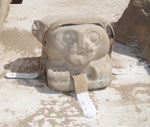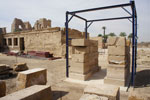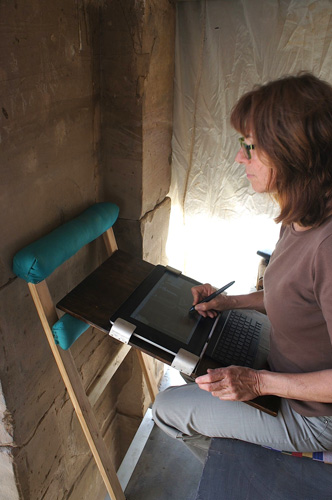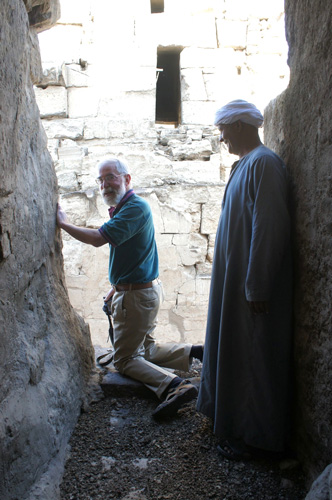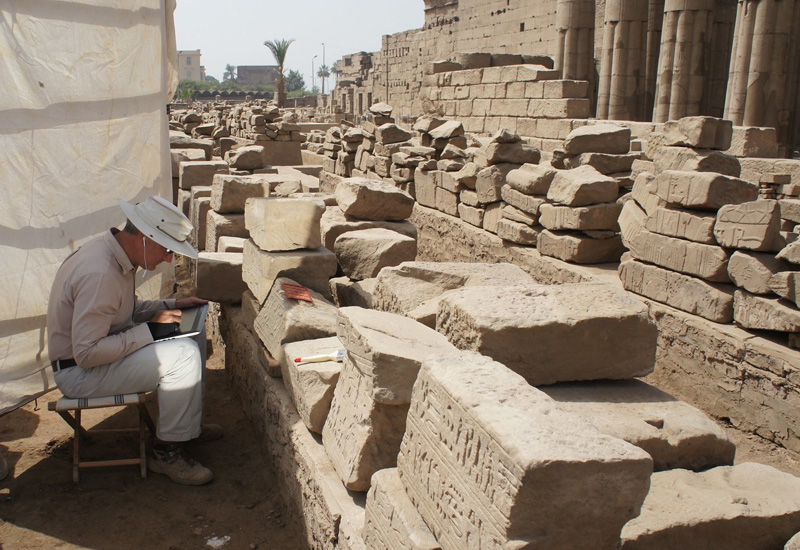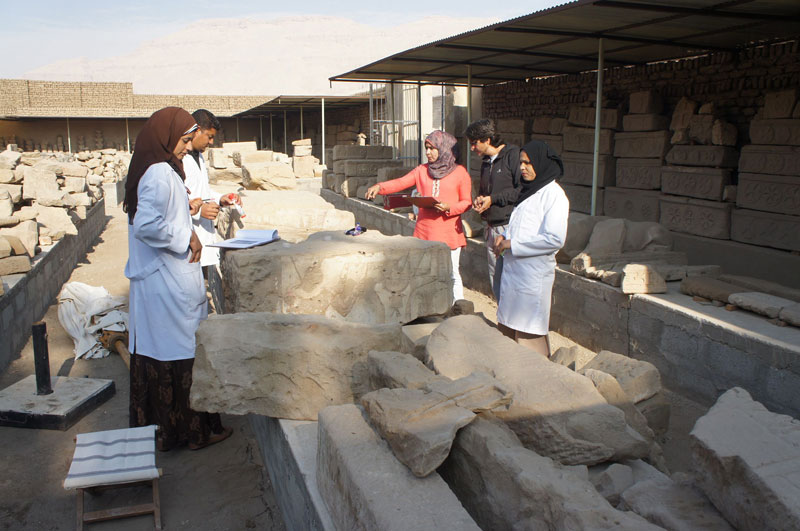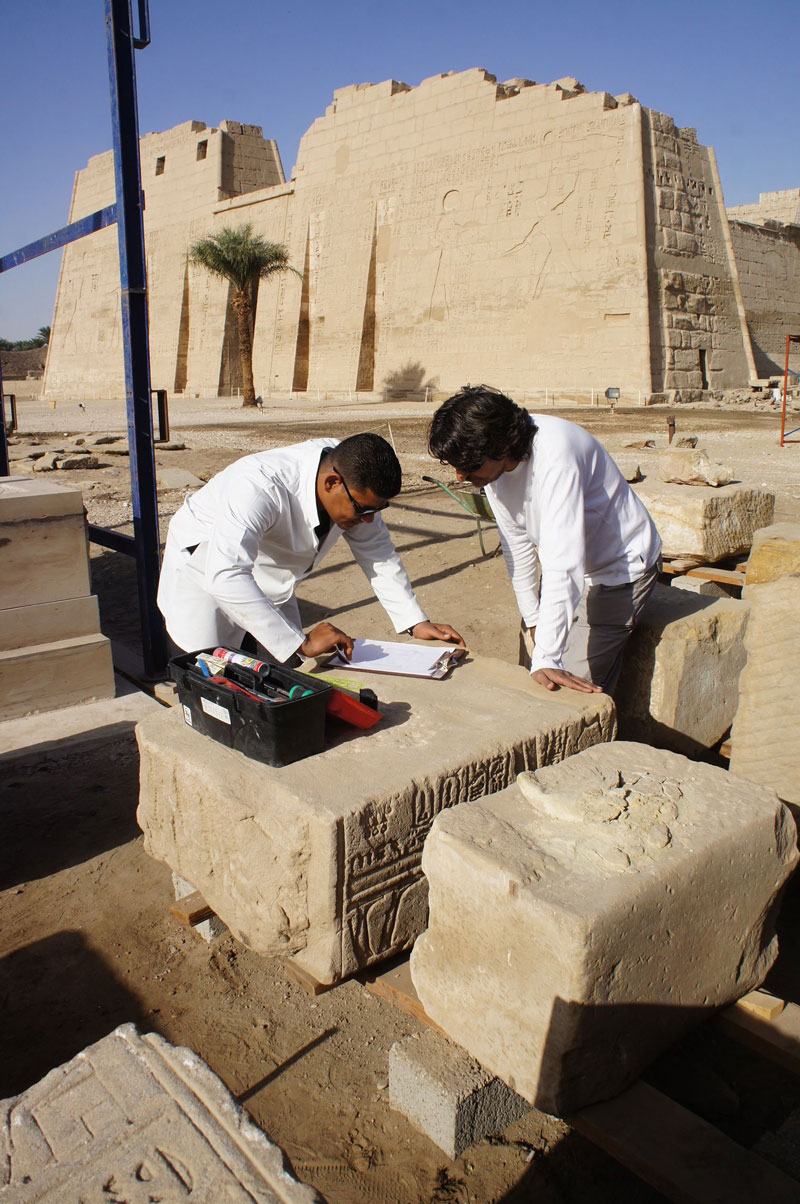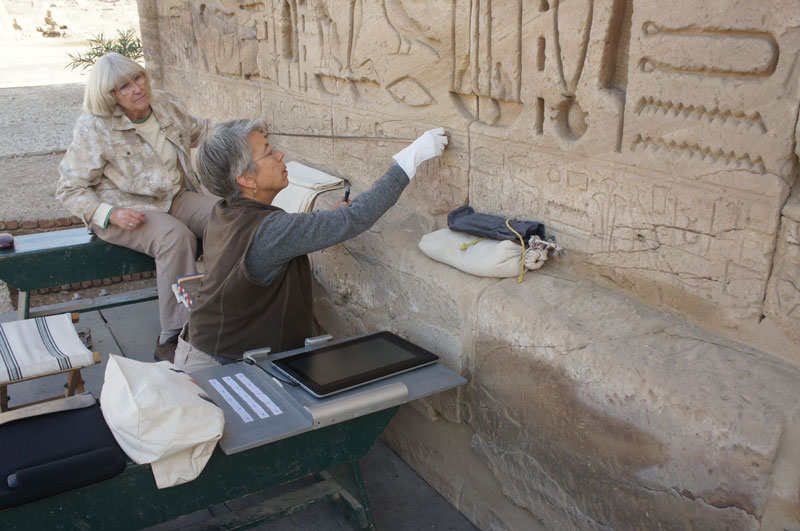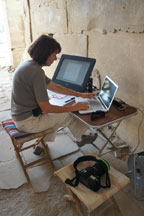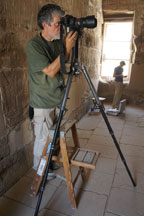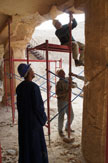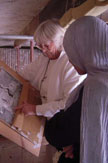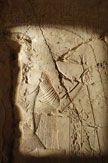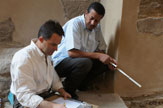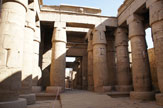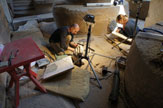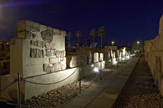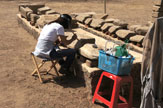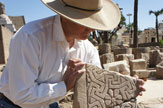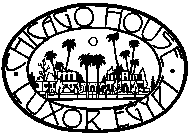
2013-2014 Field Season
May 4, 2014
Dear Friends,
On April 15th, 2014 the Epigraphic Survey completed its 2013-2014 archaeological field season (its 90th!) in Luxor. All of the staff except for Tina departed at that time, and the closing commenced immediately. Actually the closing of the house started before we all left to help maximize Tina's time. By the 15th all of the public rooms in the residence were closed, the furniture stacked in the middle of each room and covered with sheets, the carpets carried out for beating and washing, the shutters pulled down and secured over the windows, and the doors boarded up. Tina and our fabulous workmen have the closing process down to a real science, and they don't waste any time. Rule number one for the rest of us, even me, is don't get in the way!
The last few weeks went smoothly as we tied up and closed down our documentation, conservation, and restoration programs at Medinet Habu, Luxor Temple, and Khonsu Temple for the season. (Our TT 107 work was finished in February). Before we left we wrote, compiled, and I distributed preliminary reports of our season's activities to the local antiquities offices on both sides of the river, and conveyed our goodbyes to our Antiquities Ministry friends. I also distributed copies of the reports and to Mme. Amira at ARCE Cairo for official distribution to the main office of the Antiquities Ministry in Zamalek. At the same time I dropped off copies of the paperwork of the Chicago House staff, security form applications, photos, passport information, etc, for next season.
This time I also had the sad duty of submitting a report on a theft that took place in the Luxor Temple blockyard open-air museum on April 8th, in the middle of the day, two days after we had finished our work at Luxor Temple. Two small limestone Coptic lion heads in our 'animals and birds in Egyptian art' section were stolen from their mounts and are still missing. This season, because of the low numbers of tourists, the usually well-guarded blockyard area often was deserted, and this was obviously noted and taken advantage of. Both objects were bolted to the platform with aluminum bands and in a part of the blockyard visible from all sides, so it's still pretty shocking that the theft occurred at all. We assisted the Luxor Temple antiquities inspectors with documentation and descriptions of the missing objects, and my report was distributed locally and to the ministry. The small Coptic lion (or cat) heads decorated the ends of architectural elements set into mud-brick walls that supported rafters or lamps. They were excavated in the remains of buildings from the medieval Luxor settlement tell to the north of Luxor Temple that was removed in the late 1950s to expose the sphinx road beneath.
And so it goes. As I write this, Tina is just a few days away from departing Luxor after a successful closing of the Chicago House facility. Before I left she and our workmen had already shifted the Chicago House Library books to their new positions in the stacks now that the Library of Congress conversion process is finished, so it is all ready for next season's use. Mabruk, Tina! Administrator Samir, assistant Samwell, and Finance manager Essam have already moved into their summer office in Healey House (the only room in the complex with a functioning air conditioner), where they will oversee our 40 workmen over the summer months. This is where we will also hold our annual audit after Ramadan in late August, for which I will return to Luxor briefly as I always do. It is always bittersweet to be back in Luxor in the blazing hot summer, and to see Chicago House asleep and awaiting our return. By then the presidential elections will be long over, and the country will be adjusting to its new president and administration. For our friends and colleagues in Egypt it can't happen soon enough.
In the meantime, there is much to do back here at the 'mother ship,' the Oriental Institute, University of Chicago. There are many more reports to be written, articles to edit, symposia to attend, facsimile publications to produce, lectures to give, and the next Chicago House Bulletin to put together and send out. AND our annual donor appeal to initiate. You'll be hearing from me again about that soon! Bless you all for your interest and support. Have a great summer!
Warm best wishes from Chicago,
Ray Johnson, director
April 2, 2014
Dear Friends,
It's hard to believe that in two weeks everyone at Chicago House will be heading back to their various homes after a very successful and productive archaeological field season here in Luxor. Everyone, that is, except Tina, who will stay for another few weeks to supervise our workmen in the packing up and closing of the house, library and entire Chicago House facility for its five-month summer sleep. One room in Healey House - that has an air-conditioning unit - will stay open for the administration and finance team, Essam, Samir, and Samwell to use throughout the summer. Our annual audit will also take place there, for which I will return in late August. Tina and the workmen have already started cleaning out the food and kitchen magazines and are making sure that all foodstuffs are consumed before we leave. Unused dishes and cutlery are already being packed away. As is usual for this time of year, when the seasons start to change, khamsin winds prevail, and the temperatures have fluctuated up and down; last night a tremendous wind blew in cooler air, so we have a respite from the heat for a few more days. But the temperatures are definitely climbing, and it's time to go home.
At the moment we are all generating reports that I will synthesize into a short preliminary report for the Ministry of Antiquities and submit next week, basically an illustrated outline of our main activities and accomplishments since October based on the reports I receive from Brett (epigraphic documentation at Medinet Habu, Luxor Temple, TT 107, and Khonsu Temple), Lotfi (Medinet Habu conservation), Hiroko (Luxor Temple conservation), Frank (Medinet Habu stone restoration), Jen (Medinet Habu west gate survey), and Jay (Luxor Temple blockyard database). I will generate a longer, more detailed final report for submission to the Antiquities Ministry by late June, when we submit our proposal for work next season, and security applications for each staff person (reviewed by the security police each year months in advance of our arrival in October). On March 31st we completed the end of the Chicago House fiscal year, with all the accounting and administrative work that entails. So, the end of March/beginning of April is always a time of tying up administrative and financial loose ends, assessing our archaeological work, writing reports, and packing things up at our antiquities sites. In a week we will officially close our operations for the season at Medinet Habu, Luxor Temple, and Khonsu Temple. We have already finished our work at TT 107. At that time all of our equipment: ladders, scaffording, tables, chairs, carts, winches, tools, saws, lights, etc will be piled onto trucks for transportation back to Chicago House for cleaning (all the wooden ladders are oiled) and storage over the summer. This year, after the library closes on April 9th for the season, we will also be shifting the remaining books that were converted to the Library of Congress classification system to their final shelf position in the Chicago House Library main stacks, a major milestone, thanks to librarians Marie and Anait and OI VC member Andrea Dudek who helped things along.
It was a busy month, with lots of colleagues and staff in and out. Structural Engineer Conor Power left frigid Massachusetts in the middle of March and joined us for a few days to continue his annual assessment of the Luxor Temple structure and efficacy of the USAID-sponsored dewatering program(s). We both went up into the Luxor Temple Ramesses II pylon where we have installed a calibrated telltale measuring device that very simply records any movement during the course of the year, and we also have a three plumb bob lines that were set up long ago over targets embedded in the ground. Conor noted no sign of movement of any kind, indicating that the dewatering program is doing its job and the foundations of the immense architectural elements of Luxor Temple, particularly the Ramesses II pylons and great Colonnade Hall of Amenhotep III and Tutankhamun, are stable. Conor arrived for the last day of a three day rainstorm, a phenomenon that can do terrible damage to modern villages and local antiquities sites. This one was accompanied by hail and some amazing lightning displays in addition to the rain, but we were lucky this time; while there was some migration of salts to the surface of walls and fragments, all over Luxor, damage was fairly minimal. Despite the rain, Conor noted an overall, continued diminishing of salt efflorescence on the temple walls and foundations, another excellent sign that the dewatering program - inaugurated in 2006 - is working well. We are noting the same thing on the west bank where the dewatering program was inaugurated considerably later, in 2011.
The big excitement in Luxor this month was the completion and inauguration on March 23rd of two more quartzite colossi of Amenhotep III restored by our colleague Hourig Sourouzian at the Amenhotep III mortuary temple (the 'Memnon Temple') in western Thebes. These include a seated colossus from the second pylon, and a striding colossus from the great north gate, studied by Labib Habachi many years ago. Both will have company in the coming years, since both were paired with other colossal statues, now fallen and in pieces, which will also be restored and re-erected. Hourig has also partially re-erected several granite colossi that lined the southern half of the great, stone peristyle court. This year they made another join that actually involved Chicago House. In our blockyard at Medinet Habu years ago we noted a quartzite block inscribed with part of the first name (prenomen) of Amenhotep III, Nebmaatre, in large, very deep-cut sunk-relief hieroglyphs, obviously from an inscribed, Amenhotep III colossus base. We passed the block on to Hourig and her team along with a few other statue fragments in the blockyard that also clearly came from the mortuary temple. This year Hourig's team discovered where the block came from: the northern Memnon colossus, the famous 'singing colossus' of classical antiquity, where our fragment directly joins the inscribed base and completes the cartouche. How it got to Medinet Habu will always be a bit of a mystery, but it has now been restored to the original, inscribed base of the northern colossus, northern side, and is sweet to see.
There were many colleagues, friends, and associates in Luxor this month: Among them Geoffrey Martin, Mohsen el-Kamel, Piers Litherland, Judith Bunbury, and their team were in town for their western wadi geological survey. Angus Graham, Kris Strutt, and their team are just finishing their 2014 season for the Theban Harbours and Waterscapes Project. Alain and Emmanuelle Arnaudies were with us for two weeks' of work in the Photo Archives (that went all too quickly), and conservator Hiroko has already departed for home after a good two months in the Luxor Temple blockyard. Krisztian is preparing to leave for Hungary this weekend.
And so it is that time again. When next I write it will be from Chicago, with an update of our last two weeks and the transition to home. It has been a full and productive field season, thanks to our Antiquities Ministry friends, our colleagues back home, and to all of you out there who have supported our work and thereby made it all possible. Warm best wishes - and thanks - to all of you.
Best from Luxor and Chicago House,
Ray Johnson, director
March 1, 2014
Dear Friends,
February has certainly shot by quickly, but most productively. This past Thursday we finished our work for the season at the tomb of Amenhotep III's Malqata Palace steward Nefesekheru, TT 107. Senior artists Margaret De Jong and Sue Osgood finished up their drawings of the inscribed and decorated portico, and Sue drew the handful of small, inscribed limestone wall fragments that we have collected during the past couple of years. In fact, she and senior epigrapher Brett McClain found a join for one of them on the wall, the first of many to come we hope. Sue's drawing - done on one of our new Cintiq 'Companion' digital drawing tablets - will be digitally grafted onto the wall drawing. Brett initiated collation of the portico drawings starting with the inscribed column (drawn by Sue), and he finished that this past week. Work at the tomb will resume next season, and it is hoped that the entire façade will be mostly collated then.
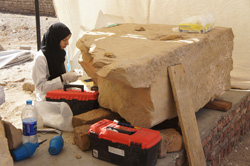 At Medinet Habu Tina Di Cerbo has adapted her 'Companion' drawing tablet to her own graffiti drawing requirements in the north Ptolemaic annex. On February 22nd, Peter Grossmann journeyed from Sheikh Abada Antinoupolis (where he and Jay Heidel have been working this month as part of the Italian Mission from Florence under the direction of Rosario Pintaudi) to consult with Tina about the Christian-period graffiti in the annex and its function at that time. Stone masons Frank Helmholz and Johannes Weninger have been cutting and preparing newly quarried Gebel Silsileh sandstone blocks for the restoration of the Egyptian-style Domitian Gate, now up to its fourth course. Conservator Lotfi Hassan assisted by Nahed Samir Andraos finished the condition surveying and treatment of the Domitian Gate blocks with our six Egyptian conservation students, and transferred their operation to the southern well of Ramesses III. The area around the well, in the past notoriously low and wet, has - I am pleased to report - dried out considerably since the activation of the USAID-sponsored west bank dewatering program in 2011, allowing us to continue our consolidation and restoration program there. The students are now carefully consolidating and putting back together the shattered upper blocks of the partly collapsed and now stabilized well, and in some cases the broken halves of the blocks will be rejoined with fiberglass dowels. Next season we will remove the decayed foundation stones on the eastern side of the well for replacement with new, damp-coursed stone blocks. At the small Amun temple photographer Yarko Kobylecky took large-format photographs of the undersides of the bark sanctuary portals - embellished with protective sun disks and vultures with outspread wings - for drawing enlargements, while Margaret and Sue continued digital drawing of the 21st Dynasty Pinudjem marginal inscrition that wraps around the exterior of the 18th Dynasty Temple. Yarko is also taking large-format reference photos of the Claudius Gate outside the the temple before we move the blocks inside later this season for treatment, and restoration starting next season. Epigrapher Jen Kimpton is continuing her cataloguing and mapping of the destroyed western High Gate blocks and fragments in preparation for a new site management program that includes moving, consolidation, and rejoining of the material starting next year.
At Medinet Habu Tina Di Cerbo has adapted her 'Companion' drawing tablet to her own graffiti drawing requirements in the north Ptolemaic annex. On February 22nd, Peter Grossmann journeyed from Sheikh Abada Antinoupolis (where he and Jay Heidel have been working this month as part of the Italian Mission from Florence under the direction of Rosario Pintaudi) to consult with Tina about the Christian-period graffiti in the annex and its function at that time. Stone masons Frank Helmholz and Johannes Weninger have been cutting and preparing newly quarried Gebel Silsileh sandstone blocks for the restoration of the Egyptian-style Domitian Gate, now up to its fourth course. Conservator Lotfi Hassan assisted by Nahed Samir Andraos finished the condition surveying and treatment of the Domitian Gate blocks with our six Egyptian conservation students, and transferred their operation to the southern well of Ramesses III. The area around the well, in the past notoriously low and wet, has - I am pleased to report - dried out considerably since the activation of the USAID-sponsored west bank dewatering program in 2011, allowing us to continue our consolidation and restoration program there. The students are now carefully consolidating and putting back together the shattered upper blocks of the partly collapsed and now stabilized well, and in some cases the broken halves of the blocks will be rejoined with fiberglass dowels. Next season we will remove the decayed foundation stones on the eastern side of the well for replacement with new, damp-coursed stone blocks. At the small Amun temple photographer Yarko Kobylecky took large-format photographs of the undersides of the bark sanctuary portals - embellished with protective sun disks and vultures with outspread wings - for drawing enlargements, while Margaret and Sue continued digital drawing of the 21st Dynasty Pinudjem marginal inscrition that wraps around the exterior of the 18th Dynasty Temple. Yarko is also taking large-format reference photos of the Claudius Gate outside the the temple before we move the blocks inside later this season for treatment, and restoration starting next season. Epigrapher Jen Kimpton is continuing her cataloguing and mapping of the destroyed western High Gate blocks and fragments in preparation for a new site management program that includes moving, consolidation, and rejoining of the material starting next year.
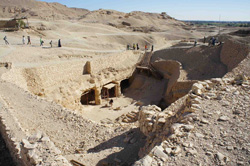 At Luxor Temple Krisztián Vertés finished drawing another major section of the Roman frescos in the Imperial Cult Chamber, south wall eastern side, for digital inking over the summer. Jay Heidel continued his digital penciling of the Bentresh block material before being loaned to the Antinoupolis team in Middle Egypt on the 13th. Brett, also loaned for a few days, accompanied him north and collated a couple of blocks at the site inscribed with hieroglyphic texts that are probably contemporary with the Hadrianic city. Looting has continued at the site, despite the presence of some new guards, and cemetery encroachment has now breached the ancient city walls, so the presence of the team even for a few weeks is important. Hiroko Kariya started her annual condition review of the Luxor Temple blockyard and with Chicago House engineer Nashet and Tina has coordinated the replacement of the canvas siding of our aluminum, covered 'hospital' mastaba/platforms. We found that a small pack of dogs had made one of them their home over the summer; the mother had obviously given birth there, and the grown dogs are now using it as their base. Nashet and Hiroko are preparing a humane mesh barrier, to keep them out of where they definitely do not belong! As part of her work this season Hiroko is also designing a maintenance program with the Luxor Temple inspectors at the site that will allow for monitoring, cleanup, and maintenance of the blockyard open-air museum.
At Luxor Temple Krisztián Vertés finished drawing another major section of the Roman frescos in the Imperial Cult Chamber, south wall eastern side, for digital inking over the summer. Jay Heidel continued his digital penciling of the Bentresh block material before being loaned to the Antinoupolis team in Middle Egypt on the 13th. Brett, also loaned for a few days, accompanied him north and collated a couple of blocks at the site inscribed with hieroglyphic texts that are probably contemporary with the Hadrianic city. Looting has continued at the site, despite the presence of some new guards, and cemetery encroachment has now breached the ancient city walls, so the presence of the team even for a few weeks is important. Hiroko Kariya started her annual condition review of the Luxor Temple blockyard and with Chicago House engineer Nashet and Tina has coordinated the replacement of the canvas siding of our aluminum, covered 'hospital' mastaba/platforms. We found that a small pack of dogs had made one of them their home over the summer; the mother had obviously given birth there, and the grown dogs are now using it as their base. Nashet and Hiroko are preparing a humane mesh barrier, to keep them out of where they definitely do not belong! As part of her work this season Hiroko is also designing a maintenance program with the Luxor Temple inspectors at the site that will allow for monitoring, cleanup, and maintenance of the blockyard open-air museum.
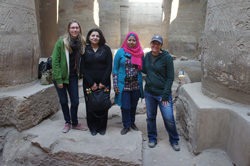 Finally, the Khonsu Temple work this month has gone extremely well, thanks to the floor-restoration efforts of the American Research Center in Egypt (ARCE) and Antiquities Ministry in the small hypostyle hall. Interestingly, all of the major reused material that epigrapher Jen and artist Keli Alberts have been carefully recording in the flooring belongs to a monument of Amenhotep III. The scenes show the king in various scales offering to both ithyphallic and anthropomorphic Amuns, but no sign of Khonsu. And no sign of any of the other types of blocks we have documented in the sanctuaries beyond, or in the court that approaches the hall. Nor are there any definitive indications of where the blocks originally came from. The material has turned to be of enormous importance and interest, as we suspected would be the case.
Finally, the Khonsu Temple work this month has gone extremely well, thanks to the floor-restoration efforts of the American Research Center in Egypt (ARCE) and Antiquities Ministry in the small hypostyle hall. Interestingly, all of the major reused material that epigrapher Jen and artist Keli Alberts have been carefully recording in the flooring belongs to a monument of Amenhotep III. The scenes show the king in various scales offering to both ithyphallic and anthropomorphic Amuns, but no sign of Khonsu. And no sign of any of the other types of blocks we have documented in the sanctuaries beyond, or in the court that approaches the hall. Nor are there any definitive indications of where the blocks originally came from. The material has turned to be of enormous importance and interest, as we suspected would be the case.
Between February 18th and 20th ARCE and Chicago House hosted a group of USAID Egypt friends led by Sylvia Atalla on a review of the USAID sponsored/funded work in Luxor, always a pleasure to show them our progress. The Malqata team led by Metropolitan Museum of Art Egyptian Department director Diana Craig Patch has finished their work for the season and will be heading home in a few days; Peter Lacovara from Emory has already departed after coordinating more brick restoration work in the main palace of the king. Betsy Bryan from Johns Hopkins has been in town this week for work at Mut Temple, and is heading home soon. It has been lovely having both groups here. Our colleague Nozomu Kawai from Waseda University, Tokyo, has been staying with us this week as he conducted research at Karnak, a special treat.
And so it goes. It's been busy! I won't tell you how beautiful the weather has been this month; you don't need to know. As we head into the last month and a half of our archaeological field season, I am pleased to report that all is well with us, and with Luxor. I will report again next month. In the meantime, best wishes from all of us here, to all of you out there!
Best from Chicago House,
Ray Johnson, director
February 4, 2014
Dear Friends,
It is hard to believe that it is already February; it seems like yesterday that I wrote to you last, a whole month ago. We are all well, but January was a momentous month for Egypt. The constitutional referendum voting took place successfully on January 14th and 15th and the country is now preparing for presidential elections perhaps as early as the end of this month or the beginning of March, with parliamentary elections afterward. Luxor was peaceful during the constitutional referendum with a good voter turnout (including our entire Egyptian staff), and even Police Day/Revolution Day on January 25th passed here joyously and peacefully, despite some disturbances in the north. Millions of people throughout the country took to the streets in celebration of the revolution, and celebrated the possibilities for real change. We share our friends' hopes.
Our January was spent working steadily and productively. We resumed our documentation work at Khonsu temple on January 20th, focuissing our efforts on reused blocks in the flooring of the Khonsu Temple Hypostyle Hall, many from the time of Amenhotep III. This hall is being cleaned and the flooring opened up by the American Research Center under the direction of ARCE associate director John Shearman in preparation for paving the areas lacking original paving stones, pried up during the medieval period. Epigrapher Jen Kimpton is coordinating the work and artist Keli Alberts is doing the drawing of the reused blocks as the ARCE workmen expose them. Brett McClain and I will do final checks of the drawings before the new floor blocks hide the reused blocks from view forever. The eastern side of the hall is now cleaned with two large, inscribed blocks exposed plus a handful of smaller fragments. Photographer Yarko Kobylecky assisted by Ellie Smith started the photography of the accessible blocks today. When the western side of the hall is finished we will tansfer our efforts there. In the meantime Keli is penciling two reused blocks visible over the doorway of chapel 11.
Krisztián Vertés returned to us on January 21st and almost immediately resumed his work penciling the Tetrarchic Roman frescos in the Imperial Cult chamber at Luxor Temple. He joins Jay Heidel who is doing facsimile drawings of the Bentresh block material in the blockyard originally identified by former Chicago House director Lanny Bell in the early 1980s, and now being readied for publication by Robert Ritner and Brett McClain for the first volume of our Luxor Temple blockyard publication series. Jay is using the new Cintiq 'Companion' drawing tablet for the initial digital 'penciling' stage of the recording process with great success. Sue Osgood has been using another 'Companion' tablet in her penciling of the 21st Dynasty Pinudjem marginal inscription that wraps around the outside of the small Amun temple across the river at Medinet Habu, and enjoying it very much. Sincerest thanks must go to our friend and colleague Dr. Margie Fisher for her generous grant that has allowed us to purchase these vital new tools a year ahead of schedule, thereby allowing us to hone our skills with them now rather than later. Thanks to Margie's generosity, Krisztián has been able to add a section to the new Digital Epigraphy manual on digital penciling techniques in addition to digital inking, again, a year ahead of schedule. The manual is bing reviewed now at the Oriental Institute and will be ready soon for uploading as an iBook, insha'Allah later this month.
Today we resumed our work at Theban Tomb 107, the tomb of Amenhotep III's Malqata palace Steward Nefersekheru. Senior artists Sue Osgood and Margaret De Jong are finishing up some drawing details on the pillared façade of the tomb, including drawing the few inscribed loose fragments that we have found so far. Senior epigrapher Brett McClain has started collating Sue's drawings of the one surviving inscribed pillar, and begun a process that we hope will be completed next season. Our resumption of the work in this tomb is well-timed, since our Metropolitan Museum of Art and Emory University colleagues (Diana Craig Patch and Catharine Roehrig from the MMA, and Peter Lacovara from Emory) have just returned to resume their archaeological and restoration work at the palace itself, and will be in residence here for the next month. As usual we are providing them with the use of one of the Chicago House Land Rovers to help facilitate their work in that extraordinary site.
At Medinet Habu, the Domition gate is rising again; under the supervision of master mason Frank Helmholz assisted by stone mason Johannes Weninger, the second course is finished and in place, and the third course is well underway. Lotfi Hassan and the six Egyptian conservation students condition-surveyed, cleaned, and consolidated (where necessary) each original block before it was put back in place, and have been working ahead of the stone masons so that each block is ready in the order in which it needs to be repositioned. It's quite a process, recquiring lots of coordination, and the results are quite beautiful. This week Lotfi and the students have turned their attentions to the shattered upper blocks of the Ramesses III southern well , threatened with collapse, that we dismantled several years ago. Now that the low area around the well is much drier, thanks to the activation of the USAID-funded dewatering program for the west bank of Luxor, it is time to start the restoration of the damaged blocks, and the replacement of the lower courses, completely decayed and turned to sand because of groundwater salts. Replacement of the foundations is scheduled to begin next season. When she is not working at Khonsu Temple these days, epigrapher Jen is continuing her survey of the destroyed and fragmentary western high gate, the preliminary stages of what will be a major documentation, conservation, and restoration effort in the seasons ahead. Richard Jasnow joined wife Tina Di Cerbo in late December to continue their graffiti documentation work at Medinet Habu until january 10th; as always it was a pleasure to have him back with us. Conservator Hiroko Kariya arrived back with us last week and is back at work in the Luxor Temple blockyards for the next couple of months. And at the moment Lotfi's wife Dina, their two sons Karim and Hani, and Dina's sister Nora are with us for an extended holiday, also a pleasure.
Photo Archivist Sue Lezon, fleeing the blizzards plaguing the midwest and east coast, spent the latter part of December and first part of January with us coordinating the Photo Archives work, optimizing scanned images for the database, supervising procurement, and preparing the way for Alain and Emmanuelles Arnaudies, who are coordinating our master database, which includes the Helen and Jean Jacquet photo archives. In addition to her work assisting Yarko photographing in the field, Ellie Smith has been scanning the Chicago House dictionery card files, a seemingly endless but extremely important task, for which we are very, very grateful.
I could go on and on, but you get the idea. We are having an entirely normal season in almost every way, and continuing to maximize our time out here. Before I sign off for this month, I must say that I work with an extraordinary group of people here at Chicago House. This evening at dinner I was given a special cake to commemorate my return to Luxor exactly one year ago today after my 'cardiac episode' and two months' convalescence in Chicago last year. I had forgotten, but the team hadn't. I am definitely blessed to work with such a remarkable group, and I am very lucky to be here, in every way.
I will write again next month with a report on our activities this month. In the meantime, please accept our very best wishes, from everyone here. Happy Valentine's Day!
Best from Chicago House,
Ray Johnson, director
January 6, 2014
Dear Friends,
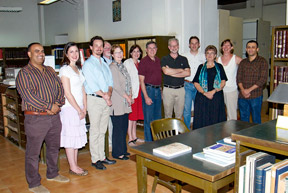 Happy New Year 2014! Chicago House rang in the New Year this week with a festive, in-house dinner, just the Chicago House team and our friends, former Egyptian Museum director Dr. Wafaa El-Saddik and husband Azmy El-Rabbat who have been with us over the holidays. While tourism is still low, Luxor saw a noticeable increase in visitors after Christmas for the New Year celebrations. At Medinet Habu the other day I met two small American tour groups, among a number of other foreign and Egyptian groups. Progress is slow but steady.
Happy New Year 2014! Chicago House rang in the New Year this week with a festive, in-house dinner, just the Chicago House team and our friends, former Egyptian Museum director Dr. Wafaa El-Saddik and husband Azmy El-Rabbat who have been with us over the holidays. While tourism is still low, Luxor saw a noticeable increase in visitors after Christmas for the New Year celebrations. At Medinet Habu the other day I met two small American tour groups, among a number of other foreign and Egyptian groups. Progress is slow but steady.
We expected this winter to be fairly quiet, but it’s been anything but; the month of December was a full one. On December 2nd I had a very cordial meeting with the current Governor of Luxor, Dr. Tarek Saad El-Din who was appointed this past summer; later in the month he paid us a visit at Chicago House. From December 3rd – 5th we were pleased to help host the visit of acting US Ambassador, Charges d’Affairs David Satterfield on a review of USAID, ARCE, and Chicago House projects in Luxor. ARCE director Gerry Scott, ARCE Associate Director John Shearman, the Chicago House team and I had much to show him, and the conversations on site and at Chicago House were stimulating and lively. On December 8th stonemason Johannes Weninger arrived to assist Frank Helmholz with the Domitian Gate reconstruction work at Medinet Habu. The first course is now complete, mostly newly quarried and shaped sandstone, and the second course is almost finished. Because more new stone is necessary for reconstruction than we originally realized, Johannes’s expertise will help us achieve our goal to finish the re-erection of the sandstone gate by the end of next season. Medinet Habu conservator Lotfi Hassan, assisted by conservator Nahed Samir and the six Egyptian conservation students have been condition-surveying, cleaning, and conserving the blocks of the gate prior to reconstruction, in coordination with the stonemasons, and doing an impressive job. Senior epigrapher Brett McClain, epigrapher Jen Kimpton, and senior artist Sue Osgood worked with artists Keli Alberts and Krisztián Vertés on the final collations and reviews of the drawings for the next volume in the small Amun temple series, Medinet Habu Volume X (as well as some drawings for Medinet Habu Volume XI), for which I have done a number of director’s checks on site. Richard Jasnow joined wife Tina Di Cerbo at Medinet Habu at the end of December to continue work on the Demotic graffiti they have been recording – and preserving – throughout the complex. All of this work, including the epigraphic documentation, is supported by a grant from USAID Egypt.
December and now January have also been a time of lots of in-house work, including updating our various databases. Photo Archivist Sue Lezon and Registrar Ellie Smith arrived in mid-December to coordinate Chicago House’s image management and have been upgrading the Filemaker-Pro Photo Archives database to Filemaker-Pro 12. Oriental Institute Visiting Committee member Andrea Dudek helped Jay Heidel adjust and expand the new Luxor Temple blockyard Filemaker-Pro database that he is now filling with data. Andrea also helped us achieve our goal of the conversion of our library holdings to the Library of Congress classification system, which was finished on December 12th. Mabruk to Chicago House librarian Dr. Marie Bryan, assistant librarian Anait Helmholz, and Andrea for this momentous achievement. There’s still some followup work to do, and the moving of the books to their final position, but the bulk of the work is now accomplished.
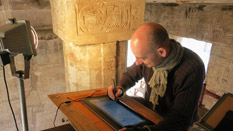 Next week after the Mulid Al Nabi, the Prophet’s Birthday, we will resume our work at Khonsu Temple, Karnak, recording inscribed, reused blocks in the flooring of the Khonsu Temple small Hypostyle Hall currently being cleaned for restoration by the American Research Center in Egypt (ARCE). The ARCE workmen will eventually fill the gaps in the flooring with new sandstone slabs, but before they do, the Chicago House epigraphic team (epigraphers Brett and Jen and artists Keli, Sue, and Jay) will record whatever inscribed surfaces are exposed, and will integrate the new data with the hundreds of other inscribed blocks we have already recorded in conjunction with ARCE’s floor restoration program throughout the temple. The entire building is constructed of blocks from earlier monuments taken down and reused by Ramesses III for quick construction of his new temple to Khonsu, and this is the first time we will have access to the reused material in this area.
Next week after the Mulid Al Nabi, the Prophet’s Birthday, we will resume our work at Khonsu Temple, Karnak, recording inscribed, reused blocks in the flooring of the Khonsu Temple small Hypostyle Hall currently being cleaned for restoration by the American Research Center in Egypt (ARCE). The ARCE workmen will eventually fill the gaps in the flooring with new sandstone slabs, but before they do, the Chicago House epigraphic team (epigraphers Brett and Jen and artists Keli, Sue, and Jay) will record whatever inscribed surfaces are exposed, and will integrate the new data with the hundreds of other inscribed blocks we have already recorded in conjunction with ARCE’s floor restoration program throughout the temple. The entire building is constructed of blocks from earlier monuments taken down and reused by Ramesses III for quick construction of his new temple to Khonsu, and this is the first time we will have access to the reused material in this area.
This week Jay has been working with Dr. Wafaa on tweaking the Arabic of three new educational signs for Luxor Temple that describe and illustrate the setting in Thebes/Waset; the pylon of Ramesses II; and the Ramesses II first court. Later in the week Jay will be resuming his digital facsimile drawing documentation of the ‘Bentresh’ and Ptolemy I blocks at Luxor temple. He will be utilizing a new tool, the Cintiq ‘Companion,’ a digital drawing tablet that now allows us to reproduce the first-stage penciling of our facsimile drawing documentation digitally. We obtained the first two of these new digital drawing tablets in December, and Tina and Krisztián have used them at Medinet Habu, testing them with great success. Kristián has already been obliged to add an appendix to the digital drawing manual on the use of the tablet as an initial penciling/documentation tool. He is back home in Hungary now with Julia and little David, putting the finishing touches on the manual that we hope to publish online very soon.
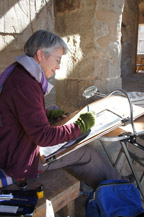 Our Christmas holiday was festive and warm. No blizzards here! (Although, as you might have heard, parts of Cairo and Sinai DID get snow in December – an extremely rare event). While a number of staff traveled home (or simply traveled) over Christmas, there were enough of us still here to enjoy a traditional holiday, with Christmas cookie decorating and distributing to our friends, Christmas tree decorating, and a lovely dinner on Christmas day with about forty Egyptian, foreign, and American guests. Our friend Ali Asfar, former Gurna Inspectorate director and Director General of Upper Egyptian Monuments, was in town and helped us celebrate. Last week Ali received a major promotion and is now Director General of Upper and Lower Egyptian Monuments – we like to say we knew him when he was ‘small.’ Mabruk, Dr. Ali!
Our Christmas holiday was festive and warm. No blizzards here! (Although, as you might have heard, parts of Cairo and Sinai DID get snow in December – an extremely rare event). While a number of staff traveled home (or simply traveled) over Christmas, there were enough of us still here to enjoy a traditional holiday, with Christmas cookie decorating and distributing to our friends, Christmas tree decorating, and a lovely dinner on Christmas day with about forty Egyptian, foreign, and American guests. Our friend Ali Asfar, former Gurna Inspectorate director and Director General of Upper Egyptian Monuments, was in town and helped us celebrate. Last week Ali received a major promotion and is now Director General of Upper and Lower Egyptian Monuments – we like to say we knew him when he was ‘small.’ Mabruk, Dr. Ali!
It has been a good and productive month. But I am saddened to acknowledge the passing of World Monuments Fund philanthropist Robert W. Wilson on December 23, 2013. The Epigraphic Survey was the lucky recipient of Robert W. Wilson’s generosity through the WMF from 2001 until 2012 with a series of ‘Wilson Challenge to Conserve our Heritage’ grants. His support allowed us to properly store and protect roughly 50,000 inscribed sandstone wall and architectural fragments in the precinct; conserve more than a thousand of them; transform the Luxor Temple blockyard eastern storage areas into a secure, protected storage facility and open-air museum; and even re-erect and restore two major fragment groups back onto their original walls, one group in the great Colonnade Hall, and another group in the Amenhotep III court. The loss to the WMF, and the world, is profound; he was a good friend to us all, and his legacy is extraordinary. We in Luxor are very grateful and proud to have had his help over the years, and we honor his memory now.
We await Egypt’s constitutional referendum and new elections this month with great anticipation, and great hope, and I will have more to say about that next month. For now, best wishes to you all, and particularly to Egypt, for a peaceful, prosperous, joyous, and productive New Year 2014.
Ray Johnson,
Director
November 29, 2013
Dear friends,
The Epigraphic Survey successfully resumed its archaeological activities at Medinet Habu on October 28th and reopened the Chicago House Library on the same day. Luxor remains peaceful; the weather continues to be warm and balmy, cooler at night; the work is going smoothly; and it is very good to be back. Instead of our annual Halloween party, this year we had a quiet, in-house dinner for all the staff on October 31st to celebrate the beginning of the season. It was the first we had seen of Nahed’s, Essam’s, and Samir’s families since April, and all of the children had grown several inches! Since we reopened, library use has been steady; we have several Egyptian students working on Master’s theses, plus two working on their PhDs, in addition to the foreign missions and MSA inspectors who routinely use the library for checking references. It’s been busy.
During the first week of November I traveled to cold, wet England to give the Amelia Edwards Memorial Lecture at the University of Bristol on November 7th about Chicago House's current work in Thebes. On my return to sunny Luxor we were pleased to host friends and colleagues Geoffrey Martin, Mohsen Kamel, and Piers Litherland, in town for their KV project, to Chicago House for a few meals and stimulating discussion. We look forward to their return in the spring. There are numerous other missions working in the area: the Spanish team working at the Mortuary Temple of Thutmosis III, the Franco-Egyptian team at Karnak, the American Research Center in western Thebes and Mut Temple, another Spanish mission at the Theban tomb of Amenhotep III’s vizier Amenhotep Huy, the Polish-Egyptian mission at Deir El Bahri, the Hungarian mission to the tomb of Imiseba, etc. More are coming, and our community is growing. A group from the US Embassy Cultural Affairs Office came by for tea and a quick library tour on November 11th after a trip south. We are noticing a slow but steady increase in tourism as the weeks have gone by and as more countries relax their travel restrictions to Egypt. It is the perfect time to come, actually. Ahlan was ahlan!
Librarian Marie Bryan returned to Chicago House on November 15th, the same day that we started a new conservation student training program at Medinet Habu under the direction of Medinet Habu conservation supervisor Lotfi Hassan, and funded by our current USAID Egypt grant. Six students who have never had field experience are now getting some excellent, hands-on experience under the watchful eye of Lotfi. The students are learning the skills needed to condition-survey and treat deteriorating stone, and are assisting in the documentation, evaluation, and treatment of the sandstone blocks of the Domitian gate, now dismantled and awaiting restoration. Later they will turn their attention to the shattered blocks of the dismantled southern well of Ramesses III, a small gate of Roman Emperor Claudius that we will be dismantling and bringing inside the blockyard for treatment this season, and numerous miscellaneous fragments in the blockyard that require consolidation. There is much to keep them occupied!
On November 17th Chicago House celebrated its 89th birthday; it’s amazing to think that we are now in our 90th year of operation, rapidly catching up to the Oriental Institute’s Assyrian Dictionary Project for longevity! On November 18th Dr. Rosario Pintaudi, director of the Istituto Papirologico “G. Vitelli” of the University of Florence, Italy, and also director of the Sheikh Abada/Antinoupolis mission, took a break from building a new guard house at Sheikh Abada, traveled to Luxor with MSA inspector Fathi Awad and stayed with us at Chicago House for a few pleasant days. That day I also took a group of about 30 members of the Luxor Syndicate of Guides through Medinet Habu to meet our team, and to brief them on our work activities, new information (including the latest gory details about Ramesses III's assassination thanks to recent DNA and CT scanning work), and current issues. The local guides are a very important bridge between the scientific community and the public, and it is important to keep them well informed; they always have terrific, thoughtful questions.
Back in the studio Krisztian has been putting together a 'manual' of our new digital inking and penciling methodologies. We are going to publish the manual in e-book format, a first for Chicago House, and perhaps even a first for the OI. It will include detailed instructions for using the new digital tools with which we have been experimenting, plus a chapter on our inking conventions, with lots of illustrations, sidebars, even videos. We hope to have it ready by the beginning of the new year to share with our interested friends and colleagues. OI VC member Andrea Dudek arrived on November 23rd and has been assisting Marie and Anait with the final stages of the Library of Congress classification conversion project. She has also assisted Jay Heidel in the designing of the new Luxor Temple blockyard database. PLUS she brought cranberries that she personally made into delicious cranberry sauce for our Thanksgiving feast last night – thank you, Andrea! We had a very good crowd, and were about 50 total, including Egyptian and foreign friends and colleagues, and lots of children. The turkey was the size of small car, and fed the whole crowd quite nicely. God bless our kitchen crew.
I should close with the news that most of you already know, the unexpected death of our friend and colleague Harold Hays in Leiden on November 20th in his sleep as a result of heart failure. He was only 48. Harold was famous for his extraordinary energy, his keen intellect, and his intense love of life. He was one of THE authorities on ancient Egyptian Pyramid Texts, and while writing his dissertation on that subject worked for five seasons with us at Chicago House as epigrapher. The year he finished his PhD, he was appointed University Lecturer in Egyptology at Leiden University. We will miss Harold’s voice, and his spirit. Our hearts are with his wife and daughter, Marga and Margui at this time.
Otherwise, we are all well, safe, working hard, and looking forward to the Christmas and New Year holidays. Seasons’ greetings in advance to you all!
Best wishes from Chicago House,
Ray
October 27, 2013
Dear Friends,
All is well with us in Luxor as the Epigraphic Survey begins its 2013-2014 archaeological field season. We are enjoying a long, slow opening, in part due to the Eid al-Adha holiday in mid-October, which delayed the completion of the paperwork by about a week, giving us some extra time to settle in. I was in Cairo at the beginning last week signing the contract for the season at the Ministry of State for Antiquities and meeting with our MSA, ARCE, USAID, and US Embassy friends. We received our work permissions and all of our security clearances, and I delivered copies of the signed contract to the east and west bank inspectorates a few days ago. We are all set to resume our epigraphic, conservation, and restoration work at Medinet Habu tomorrow (Monday, October 28th) when we will transfer our equipment to the temple site, meet our MSA inspectors, and reopen the small Amun temple and blockyard. We will also be opening the Chicago House library.
Egypt is a very different place from when the team was last here in April, but we have been warmly welcomed back. There are modern, armored troop carriers everywhere, in front of churches and hotels, and security is excellent. The mood is calm, even in Cairo. Luxor is quiet, but not entirely bereft of tourists. There were tour groups on my flights to Luxor, and the official word from the Luxor governor is that tourism is 12% now, up from 2% last month. We've seen a couple of tour boats on the Nile, and I saw a bus full of tourists the other day. It will take some time, but more and more countries are easing their travel restrictions, and we expect to see a steady increase as the weeks go by.
The days are warm, but the nights are unseasonably cool, even in Luxor (not a complaint!). The house and grounds are clean and beautiful, thanks to the efforts of our workmen and Tina Di Cerbo, who came a month early to supervise the opening and maintenance work. The kitchen plumbing (from 1930) failed at the end of last season and had to be completely replaced. Since the floor tiles had to be torn up they were replaced as well, the stove fan was replaced, and all the woodwork was redone. The kitchen is now sparkling new and fully functional, again thanks to Tina and our intrepid, skilled workmen.
But there has been sadness as well. On October 16th, on his way to work, Chicago House assistant cook Ibrahim Elias had a heart attack and died before the ambulance could get him to the hospital. A big, burly, gentle man, Ibrahim began work with us in 1995 and was one of the pillars of our staff. He always arrived around 5:00 AM each day to start the prep work in the kitchen and feed the early risers, and was one of the most sweet-natured human beings I have ever known, always smiling, always with a good word for everyone. A number of us attended his funeral at the new St. Malak Church and his burial in the historic St. Pakhom Monastery (Deir El Shayeb) cemetery outside of Luxor. He leaves a real hole in our ranks, and we will miss him terribly.
Otherwise, everyone else is well. The workmen are cleaning and preparing the ladders, scaffolding, and other equipment for transport on Monday, and we are looking forward to resuming our work at the temple sites.
I will be in touch again next month with an update on our activities. In the meantime, best wishes to you all for an excellent autumn from everyone here. Happy Halloween!
Best from Luxor,
Ray Johnson, Director
September 1, 2013
Dear Friends,
I am pleased to report that despite the disturbances in Egypt during the month of August, Chicago House remains secure and safe. Our Egyptian administration staff, Samir Guindy and Samwell Maher, and senior accountant Essam El-Sayed report that Luxor is peaceful and quiet. Our Egyptian workmen, who double as guards during the summer months we are away, have done a beautiful job of protecting the Chicago House facility, and things are getting back to normal. The annual Chicago House audit with KPMG started this past Sunday, August 25th in Luxor and is scheduled to finish on September 5th. I am departing for Egypt on Monday, September 2nd and will be present for the conclusion of the audit on September 4th, our usual program. While in Luxor I will touch base with our antiquities friends and colleagues, visit the new Antiquities Ministry Luxor director and the new governor, and arrange for our archaeological field season. I will spend two days in Cairo afterward and will see more colleagues there, and be back in Chicago on September 11th.
If things remain peaceful we plan on returning to Luxor to resume our documentation and conservation programs at the usual time, October 15th – April 15th. If the situation changes, we will modify our program accordingly. Tina Di Cerbo is arriving in Luxor the first week of September to resume maintenance work at the house (all the kitchen water pipes are being replaced) and start the opening and cleaning process.
Thank you all for your thoughts and concern. Things are good in Luxor, and Chicago House is well-guarded, by our workmen and by the Luxor City police. As is usual during the summer months the house is still closed (except for the finance and administration office) and the foreign professional staff members are all in their respective home countries for the summer: the USA, Canada, Hungary, Japan, Germany, the Netherlands, Italy, and France. We are all looking forward to returning in October to resume our preservation work in Luxor, inshallah.
I will keep you all posted, and will be in touch again in early October. Best and thanks for your concern, your friendship, and your support.
Ray Johnson, director, Epigraphic Survey
2012-2013 Field Season
September 1, 2013
Dear Friends,
I am pleased to report that despite the disturbances in Egypt during the month of August, Chicago House remains secure and safe. Our Egyptian administration staff, Samir Guindy and Samwell Maher, and senior accountant Essam El-Sayed report that Luxor is peaceful and quiet. Our Egyptian workmen, who double as guards during the summer months we are away, have done a beautiful job of protecting the Chicago House facility, and things are getting back to normal. The annual Chicago House audit with KPMG started this past Sunday, August 25th in Luxor and is scheduled to finish on September 5th. I am departing for Egypt on Monday, September 2nd and will be present for the conclusion of the audit on September 4th, our usual program. While in Luxor I will touch base with our antiquities friends and colleagues, visit the new Antiquities Ministry Luxor director and the new governor, and arrange for our archaeological field season. I will spend two days in Cairo afterward and will see more colleagues there, and be back in Chicago on September 11th.
If things remain peaceful we plan on returning to Luxor to resume our documentation and conservation programs at the usual time, October 15th – April 15th. If the situation changes, we will modify our program accordingly. Tina Di Cerbo is arriving in Luxor the first week of September to resume maintenance work at the house (all the kitchen water pipes are being replaced) and start the opening and cleaning process.
Thank you all for your thoughts and concern. Things are good in Luxor, and Chicago House is well-guarded, by our workmen and by the Luxor City police. As is usual during the summer months the house is still closed (except for the finance and administration office) and the foreign professional staff members are all in their respective home countries for the summer: the USA, Canada, Hungary, Japan, Germany, the Netherlands, Italy, and France. We are all looking forward to returning in October to resume our preservation work in Luxor, inshallah.
I will keep you all posted, and will be in touch again in early October. Best and thanks for your concern, your friendship, and your support.
Ray Johnson, director, Epigraphic Survey
April 1st, 2013
Dear Friends,
It has been a full and productive month since I wrote last, and the temperatures in Luxor have skyrocketed into the 100s F…! It must be spring. Our documentation, conservation, and restoration work continued at Medinet Habu and Luxor Temple, and documentation resumed at Khonsu Temple Karnak this month, with good progress made at each site. Jay Heidel is collating his drawings of the beautifully carved Arch #2 blocks from the Thecla Church at Luxor Temple. Coached by Krisztián Vertés in the mysteries of the Wacom drawing tablet, he has also started the digital inking of the inscribed Thutmosis III granite pilaster cut in half and reused in the church to support Arch #2, and is enjoying these new tools that make the inking process go faster with even more accuracy. Just today (April 1) we erected the second orientation panel for the Luxor Temple precinct designed by Jay, featuring a ground plan of the entire precinct and labels and descriptions in English and Arabic. Structural engineer Conor Power has been here this week doing his annual structural survey of the sites in our concessions, and he reports that all is stable, thanks in large part to the USAID-funded dewatering programs on both sides of the river. Conservator Hiroko Kariya finished her condition- surveying and blockyard open-air museum maintenance for this season and departed on March 20th. At Medinet Habu artists Margaret De Jong and Keli Alberts resumed work on the Pinudjem inscription that wraps around the outside of the small Amun temple, while Tina Di Cerbo is digitally recording graffiti, much of it from the Christian period, inside the northern Ptolemaic annex. Stone mason Frank Helmholz and his team have been cutting and shaping new lower course sandstone blocks for the re-erection of the gate of Domitian with beautiful results; the entire lowest course is now finished and looks sensational. Conservator Lotfi Hassan, Nahed Samir Andraos, and their team have desalinated, conserved, and prepared a large stone lintel block for topping off the Domitian Gate. They have also been sorting through door jamb and lintel fragments of Ramesses III for material for the open-air museum displays, and treating miscellaneous gate and architectural fragments that require conservation. At Khonsu Temple photographer Yarko Kobylecky took large-format shots of a number of reused blocks in the walls and ceiling areas of the back shrines. These blocks relate to reused block material in the flooring and foundations that we have been recording the last few years, quite a bit of it from an earlier 18th and 19thDynasty Khonsu Temple. Epigrapher Jen Kimpton and artist Keli Alberts are now tracing and collating additional reused material in the walls that will be incorporated into our study of these exciting remnants of the earlier temple to the moon god. Special thanks must go to the American Research Center in Egypt and Luxor director John Shearman for allowing us to use some of their scaffolding for this work.
Sue Lezon was back with us from March 7 through the 21st, working with Ellie and Tina in the Photo Archives primarily on the Helen and Jean Jacquet archives slides. From March 16th to 30th Alain and Emmanuelle Arnaudies joined us to work on our master database, continue to enter data from Medinet Habu and Luxor Temple, and to record missing negatives that may be duplicated back home. There have been many visitors passing though this month, including the Oriental Institute Tour led by former Epigraphic Survey director Lanny Bell and accompanied by OI development director Tracy Tajbl. They enjoyed a reception and library briefing with us on the 14th, and site visits during the next few days. We also had the pleasure of hosting a group of USAID Egypt friends from Cairo for a review of our work the same week, and are preparing to host the new mission director of USAID Egypt Mary Ott tomorrow for a similar review. We are greatly indebted to USAID Egypt for the recent extension of a grant that will help support our preservation work on both sides of the river into 2015. I should also mention that artist Egyptologist Krisztián Vertés finished up his work for the season a bit early this year and headed home to Budapest to await the birth of his and Julia's first child, due this month.
Luxor remains peaceful and is doing a brisk tourist trade, but other parts of Egypt aren’t faring so well, and the lack of attention is resulting in some real damage to a number of out-of-the-way cultural heritage sites. On March 6th I traveled to Cairo where I joined Dr. Rosario Pintaudi of the Italian Mission to Sheikh Abada / Antinoupolis and inspector Fathy Awad Reyad in a gesture of solidarity for a meeting with the Minister of State for Antiquities, Dr. Mohamed Ibrahim. The ancient Roman city of Antinoupolis, located just north of Amarna in Middle Egypt, like many other sites throughout Egypt (Dashur, El Hiba, Al Bordan in the delta, even Amarna) has been subjected to accelerating looting and destruction as the Egyptian police presence continues to remain sparse. Antinoupolis in particular is threatened on all sides by agricultural, settlement, and cemetery expansion. And now, like in Dashur, the locals have brought in heavy equipment. Between October 2012 and February 2013 the northern half of the great hippodrome – the only ancient horse-race track that survives in Egypt, almost as large as the Circus Maximus in Rome – was bulldozed flat to expand the adjacent cemetery. It is a terrible, irrecoverable loss, and a real tragedy for cultural heritage preservation. Thanks to the quick response of the minister, a presidential decree has been issued adding to the protected antiquities land of the site, and proclaiming that any development of the area is in violation of the law. It is an important first step. The next is to get armed guards on the site, also in the works. During this interim time it is crucial to protect Egypt’s archaeological sites, now. Only by all of us working together can we do so, and Chicago House will do what it can to help.
That’s all for now. We are heading into the last two weeks of the season, and will close our doors on October 15th and put the Chicago House facility to sleep for the summer. In the meantime we have much to do to finish our work for the season, finishing up our operations at all of our temple sites, and writing the necessary reports for the Egyptian government, Oriental Institute/University of Chicago, and our granting agencies. But it’s also a time of looking forward to the season to come, as we make our plans and write our application for the rich season ahead. I will be in touch!
Best wishes to you all from Luxor,
Ray Johnson, director
February 28, 2013
Dear Friends,
As I write this we are heading into the last month and a half of our six-month, 2012-2013 archaeological field season, and this past month has been a full one. Luxor has experienced a steady and dramatic rise in temperature, from frigid at the beginning of the month to over 90 degrees F this week, quite a contrast to the snowbound midwestern and northeastern USA our friends back home are experiencing at the moment. I want you all to know that it’s TOO hot here, but we are coping as best we can!
At the beginning of February Oriental Institute VC member Andrea Dudek finished another month working with Chicago House librarian Marie Bryan and assistant librarian Anait Helmholz on the conversion of our library holdings (20,000 volumes) to the Library of Congress classification system, a project now in its final stages. Completed were all the ‘B’s and 75 ‘A’s with 437 titles and 552 volumes completed. Thank you Andrea for helping us get to the final stretch of this project! We’re almost there…
Jay Heidel and I returned to Luxor on February 4th and to a very warm welcome at Chicago House: the whole team met us with red carpets, local musicians, stick dancing, and lots of flowers. It is very sweet to be back after our two-month hiatus in the USA. I have spent the last weeks reviewing the considerable amount of work done while I was away, and have been briefed on the new digital drawing techniques using Wacom drawing tablets in which the art staff has become amazingly proficient in a very short time. I did the final director’s review of a particularly interesting drawing of Sue Osgood’s at Medinet Habu last week that is historic in several ways. First, it is the facsimile drawing of a façade pillar of the small Amun temple that is three-quarters concealed behind a later Ptolemaic wall, therefore mostly invisible, yet the drawing shows the complete pillar face. Sue penciled and inked the exposed part of the pillar on a normal photographic drawing enlargement a while ago. Subsequent aluminum foil rubbing of the inscribed areas in the small space between the two walls allowed Sue to document the obscured details, after which tracings of her rubbings were digitally photographed, reduced, digitally ‘inked’ by her this season, and finally joined with a high-res scan of the original inked drawing. The finished, digitally printed drawing represents an historic fusion of the two drawing techniques, a seamless joining of India-inked and digitally ‘inked’ drawings. It is absolutely impossible to see the difference between the two. Using Photoshop and the new Wacom drawing tablets, the art team (Sue, Margaret De Jong, Kristián Vertés, and Keli Alberts) showed me how they can now match the excellence of our normal inking conventions while improving on the accuracy and precision of the drawings, building on digital drawing techniques pioneered by Egyptologist Tina Di Cerbo a decade ago. Egyptologist/artist Kristián has led the way in developing the new techniques now so expertly utilized by the whole crew, and my hat is off to them all. Special thanks to the University of Chicago Women’s Board and to dear friend and colleague Margie Fisher for funding this tremendously exciting new chapter in our documentation program!
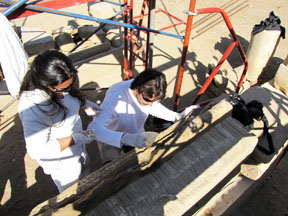 Conservator Lotfi Hassan was also busy while I was away, conserving and consolidating numerous architectural fragments in the Medinet Habu blockyard. He and his team matched and joined more than a dozen Ramesses III – period sandstone doorway elements, beautifully inscribed jambs and lintels, and tested the joins of whole doorways for the blockyard open-air museum. Most of this material was excavated in the 1920s by Üvo Hölscher for the University of Chicago where he found the blocks reused throughout the medieval city, but the material originally comes from the mud-brick administrative areas and magazines around Ramesses III’s mortuary temple. Conservator Nahed Samir Andraos consolidated a four-ton, two and a half-meter long lintel block originally from the top of the Domitian Gate, found at Medinet Habu after the gate was re-erected by Georges Daressy in the late 19th century. Nahed successfully treated the decayed areas and reinforced the crumbling top of the block with strong but breathable lime mortar. It will eventually be one of the last, crowning blocks to be restored to the gate. Stone mason Frank Helmholz has been shaping new stone blocks freshly quarried from Gebel Silsileh to replace the decayed lowest course of the gate. He and his team started moving them into place onto the new, damp-coursed, reinforced-concrete foundation platform this month. Domitian's gate will rise again!
Conservator Lotfi Hassan was also busy while I was away, conserving and consolidating numerous architectural fragments in the Medinet Habu blockyard. He and his team matched and joined more than a dozen Ramesses III – period sandstone doorway elements, beautifully inscribed jambs and lintels, and tested the joins of whole doorways for the blockyard open-air museum. Most of this material was excavated in the 1920s by Üvo Hölscher for the University of Chicago where he found the blocks reused throughout the medieval city, but the material originally comes from the mud-brick administrative areas and magazines around Ramesses III’s mortuary temple. Conservator Nahed Samir Andraos consolidated a four-ton, two and a half-meter long lintel block originally from the top of the Domitian Gate, found at Medinet Habu after the gate was re-erected by Georges Daressy in the late 19th century. Nahed successfully treated the decayed areas and reinforced the crumbling top of the block with strong but breathable lime mortar. It will eventually be one of the last, crowning blocks to be restored to the gate. Stone mason Frank Helmholz has been shaping new stone blocks freshly quarried from Gebel Silsileh to replace the decayed lowest course of the gate. He and his team started moving them into place onto the new, damp-coursed, reinforced-concrete foundation platform this month. Domitian's gate will rise again!
Artists Sue and Margaret finished the penciling of the exquisitely carved but very fragile Theban Tomb 107 reliefs of Amenhotep III’s Malqata palace steward Nefersekheru on February 12th. They will finish inking the drawings over the summer, with collation by the epigraphic team scheduled to begin next season.
Among the many visitors to Chicago House this month were OI VC member Aimee and Peter Rossi, Bill Petty, former OI Museum Chief Curator Geoff Emberling (fresh from his first season excavating in El Kurru in North Sudan), geophysicist Kris Strutt, conservators Alberto Succato and Emiliano Abrusca of the ARCE Red Monastery conservation project, Peter Lacovara of the Emory University Malqata team, Matt Adams and Michelle Marlar working at Abydos, and Bob and Pat Brier and their Far Horizons group. Kris and Jay will be returning from Antinoupolis next week where they have been working with the Italian team from Florence under the direction of Dr. Rosario Pintaudi doing magnetometry surveying and testing of the threatened parts of the Roman city, with wonderful results.
Tomorrow, March 1st, marks the beginning of my 17th year as Epigraphic Survey director. The last sixteen years certainly have passed quickly! It is a great pleasure and privilege to be working with our Egyptian and foreign colleagues in common bond toward the preservation of Egypt’s precious cultural heritage through our documentation, conservation, and restoration efforts. There is nothing more satisfying, or challenging, and I am very, very grateful to all of you out there whose friendship and support help make it happen. Thank you!
I will write again in a month with another update. In the meantime, please accept our best wishes to you all, from everyone here at Chicago House,
Ray Johnson
January 31, 2013
Dear Friends,
 Luxor remains peaceful despite the recent unrest to the north, and the work is going well. The Chicago House staff celebrated a quiet New Year's Eve and has been working steadily at Medinet Habu, Theban Tomb 107, and Luxor Temple throughout the month. Although Julia Schmied is now back in Hungary awaiting the birth of her and Krisztián Vertés's first child, she has been working long distance with conservator Lotfi Hassan and Krisztián on the documentation and reassembly of sandstone doorjamb fragments in the MH blockyard. These are from late Ramesside and Third Intermediate Period houses built within the MH precinct, excavated by archaeologist Uvo Hölscher and the University of Chicago in the 1920s. The mud-brick houses of officials who worked in the precinct often had stone doorframes inscribed with their names. These houses were later dismantled and recycled in the medieval city that grew within Ramesses III's enclosure walls, where they were recovered when the temple precinct was excavated and cleared. The reconstruction of the doorways - on paper and physically in the blockyard - is yet another groundbreaking addition to our Medinet Habu documentation and restoration programs. Photographer Yarko Kobylecky assisted by Ellie Smith is photographing the material now, and we are studying ways to integrate the restored doorways into our open-air museum display for public view. Stone mason Frank Helmholz and his team received several shipments of freshly quarried sandstone from the Gebel Silsileh quarries during the month for the ever-growing restoration work in the complex. Frank continued shaping replacement blocks for the decayed lower courses of the Gate of Domitian for restoration later in the season.
Luxor remains peaceful despite the recent unrest to the north, and the work is going well. The Chicago House staff celebrated a quiet New Year's Eve and has been working steadily at Medinet Habu, Theban Tomb 107, and Luxor Temple throughout the month. Although Julia Schmied is now back in Hungary awaiting the birth of her and Krisztián Vertés's first child, she has been working long distance with conservator Lotfi Hassan and Krisztián on the documentation and reassembly of sandstone doorjamb fragments in the MH blockyard. These are from late Ramesside and Third Intermediate Period houses built within the MH precinct, excavated by archaeologist Uvo Hölscher and the University of Chicago in the 1920s. The mud-brick houses of officials who worked in the precinct often had stone doorframes inscribed with their names. These houses were later dismantled and recycled in the medieval city that grew within Ramesses III's enclosure walls, where they were recovered when the temple precinct was excavated and cleared. The reconstruction of the doorways - on paper and physically in the blockyard - is yet another groundbreaking addition to our Medinet Habu documentation and restoration programs. Photographer Yarko Kobylecky assisted by Ellie Smith is photographing the material now, and we are studying ways to integrate the restored doorways into our open-air museum display for public view. Stone mason Frank Helmholz and his team received several shipments of freshly quarried sandstone from the Gebel Silsileh quarries during the month for the ever-growing restoration work in the complex. Frank continued shaping replacement blocks for the decayed lower courses of the Gate of Domitian for restoration later in the season.
The epigraphic team continued to work on Volume X and XI in our small Amun temple series at Medinet Habu. But January also saw the beginning of an exciting new epigraphic documentation program at Luxor temple in the King's Chamber/Imperial Cult Chamber. Egyptologist/artist Krisztián inaugurated the facsimile drawing of the late 3rd century AD Roman frescos in the Imperial Cult Chamber recently cleaned and consolidated in a collaboration between the American Research Center in Egypt and Chicago House. The frescos and Amenhotep III reliefs that they partially cover will be presented in future volumes of the Epigraphic Survey's 'Reliefs and Inscriptions at Luxor Temple' series. Krisztián, our digital inking pioneer, started the penciling of the first section of frescos, and will be inking both frescos and reliefs digitally utilizing the innovative new methodology he has devised. Mabruk on an excellent start, Krisztián!
Conservator Hiroko Kariya is now back with us, splitting her time between the Luxor Temple blockyard conservation program and Abydos where she helps coordinate the conservation work there for the NYU/Institute of Fine Arts mission directed by Matt Adams. The Metropolitan Museum of Art/Emory University Joint Expedition to Malqata team (JEM) arrived in Luxor this month to resume their excavation and restoration work in Amenhotep III's Malqata palace, south of Medinet Habu. The team is now too big to be accommodated at Chicago House, but we are still assisting them with the loan of one of our land rovers. It's great to have them back in Luxor.
And I am pleased to report that on January 28th I officially finished my cardio-rehabilitation program at the University of Chicago hospital, and have been cleared to return to Egypt. Jay and I will start our trip on February 2nd and will be back in Luxor on February 4th. I can't wait.
Best wishes to you all,
Ray Johnson
January 3, 2013
Many of our readers know that I am presently back in Chicago after experiencing what my doctors report was a ‘small’ heart attack on December 1st in Luxor. I was transferred to Cairo the afternoon of the 2nd where I had a successful angioplasty / stent operation at the As-Salaam International Hospital in Maadi early on the 3rd. Jay Heidel and I flew back to Chicago on December 8th where I have been resting and under observation ever since. This week I started a cardiac rehabilitation and physical therapy program at the University of Chicago hospital. Tests show that the stent corrected the problem area and the rest of my heart is healthy. When my doctors are satisfied that I have made good progress with my rehab, I will be allowed to return to Egypt, we hope by the end of the month.
In the meantime, the work at Chicago House has continued without interruption, coordinated by the ever-intrepid Chicago House team. A new digital epigraphy training program was inaugurated under the tutelage of Egyptologist / epigraphic artist Krisztián Vértes, who for the first three weeks of December inducted the entire epigraphic staff of artists and epigraphers into the mysteries of digital inking and collating utilizing Wacom drawings tablets, Photoshop software, and a whole host of tricks. Sincerest thanks to the Women’s Board of the University of Chicago and Margie Fisher for underwriting this exciting new program.
Additionally, and at the request of our Ministry of State for Antiquities (MSA) friends, staff photographer Yarko Kobylecky took digital reference photographs for the MSA of the newly cleaned reliefs and paintings of Ptolemy VIII Euergetes II in the small temple of Qasr El Agouz immediately to the south and east of Medinet Habu. Recent epigraphic and archaeological work there by the University of Strasburg and Supreme Council of Antiquities (SCA) indicates that the focus of the three chapels was Amun of Djeme (resident at the Medinet Habu small Amun temple) and the god Thoth. The cleaning of the well-preserved paintings was recently finished by MSA conservators with excellent results.
Stone mason Frank Helmholz, conservator Lotfi Hassan, and the epigraphic team also did a condition study and preliminary cleaning of a partially preserved, small sandstone gate of the Roman Emperor Claudius located outside of the Medinet Habu precinct, east side, south end. This gate, in precarious condition for years, has recently had its foundations further weakened by ground water sat decay. Chicago House asked for and received permission to add it to its conservation and restoration program this season, as a logical complement to our work with the gate of Domitian inside the Medinet Habu temple complex. I will have more to report on the Claudius gate and our other projects the next time you hear from me.
In the meantime, on behalf of the entire Chicago House team, please accept our very best wishes for a happy, healthy, and wonderful New Year 2013.
Yours,
Ray Johnson
November 29, 2012
Dear Friends,
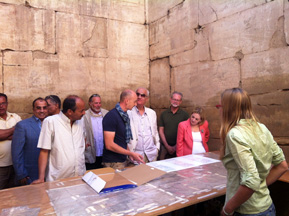 I can honestly say that this past month - and the last two weeks in particular - have been among the busiest in all my years with the Epigraphic Survey. Our archaeological work has gone very well, with the entire epigraphic team working on the last drawings for Medinet Habu X, the second volume in the small Amun temple series dedicated to the 18th Dynasty Temple square-pillared ambulatory. Artist/Egyptologist Krisztian Vertes has been putting the finishing touches on his study of the multiple painting phases in the ambulatory, which will be included in the volume as a separate chapter. I have been reviewing final drawings at the wall with the artists, checking them off our list one by one. Lotfi Hassan and the conservation team have continued work in the blockyard with Julia Schmied, assembling and conserving architectural fragments from private houses excavated by Hölscher long ago. Yarko photographed another 24 architectural fragments for Julia's study, mainly broken doorframes, and has been kept busy in the darkroom preparing photographic drawing enlargements for the artist team. Lotfi, stone mason Frank Helmholz, and engineer Nashet paid a visit to the Gebel el-Silsileh sandstone quarries a few days ago to arrange for new stone to be quarried for the Domitian Gate restoration work. Frank has already started shaping new stones for the lower courses of the gate that were destroyed by groundwater salt. Architect Jay Heidel has been drawing and collating Thecla Church blocks in the Luxor Temple blockyard, focusing now on blocks of Arch Number 2.
I can honestly say that this past month - and the last two weeks in particular - have been among the busiest in all my years with the Epigraphic Survey. Our archaeological work has gone very well, with the entire epigraphic team working on the last drawings for Medinet Habu X, the second volume in the small Amun temple series dedicated to the 18th Dynasty Temple square-pillared ambulatory. Artist/Egyptologist Krisztian Vertes has been putting the finishing touches on his study of the multiple painting phases in the ambulatory, which will be included in the volume as a separate chapter. I have been reviewing final drawings at the wall with the artists, checking them off our list one by one. Lotfi Hassan and the conservation team have continued work in the blockyard with Julia Schmied, assembling and conserving architectural fragments from private houses excavated by Hölscher long ago. Yarko photographed another 24 architectural fragments for Julia's study, mainly broken doorframes, and has been kept busy in the darkroom preparing photographic drawing enlargements for the artist team. Lotfi, stone mason Frank Helmholz, and engineer Nashet paid a visit to the Gebel el-Silsileh sandstone quarries a few days ago to arrange for new stone to be quarried for the Domitian Gate restoration work. Frank has already started shaping new stones for the lower courses of the gate that were destroyed by groundwater salt. Architect Jay Heidel has been drawing and collating Thecla Church blocks in the Luxor Temple blockyard, focusing now on blocks of Arch Number 2.
This month has been a social whirlwind as well. At the beginning of the month we hosted Emily Teeter and her tour group to site visits and a reception at Chicago House. An Egypt Exploration Society tour led by EES director Chris Naunton was in town for a week and stopped by Medinet Habu; it was a pleasure to host Chris and colleague Kristin Thompson, working on Amarna sculpture fragments, to dinner one night. I took a few days during the second week of November to lecture in Denmark at the University of Copenhagen about the work of the Epigraphic Survey and some of our work that sheds new light on the reign of Tutankhamun. On November 14th we hosted a dinner for the Chicago House workmen, who with Tina during the opening of the house in September were faced with daunting, unexpected maintenance challenges and yet still got the house open on schedule. They all deserved a good dinner, and much, much more. And on November 17th we celebrated Chicago House's 88th birthday!
Then things really picked up. On the 18th and 19th we had a USAID review of our USAID-sponsored work at Luxor Temple and Medinet Habu. On November 22nd the GOE sponsored a PR event in the Kings' Valley to commemorate the opening of Tutankhamun's tomb, and to open the tomb of Merenptah, whose granite sarcophagi had recently been reassembled and restored by our colleagues Ted and Lyla Brock. The Minister of State for Antiquities (MSA) Dr. Mohamed Ibrahim and his entourage attended the event, plus US Ambassador Anne Patterson and her husband David, as well as the Minister of Tourism, the 8th Earl of Carnarvon and his wife Fiona (who a few years ago joined us for dinner at Chicago House), the Governor of Luxor Dr. Ezzat Saad, the Russian Ambassador, and a host of MSA and other dignitaries. The KV opening was followed by speeches and a banquet on the grounds of Carter House, Howard Carter’s recently restored residence at the mouth of the Valley of the Kings (now ‘Carter’s Café’). The following morning the Minister and Ambassador Patterson joined us at Medinet Habu for a review of our work and a walk through the temple complex, followed by a very pleasant luncheon at Chicago House attended by our library patrons and foreign and Egyptian colleagues, with whom the ambassador was able to chat informally. The next day we hosted another Medinet Habu review and luncheon for ‘Friend of Chicago House’ Aly Tahry, who had visited Chicago House during FOCH Thanksgiving weekends in the early 1990s. It was good to have him back.
As you are aware, the Valley of the Kings PR event to bring tourists back to Egypt was somewhat undone by the actions of Egypt’s president the next day. Egypt is still sorting this out. Long ago I had agreed to speak about the work of Chicago House at the MSA lecture series in Zamalek on November 26th, this past Monday. Demonstrators were gathering in Tahrir Square to protest the president's actions, but I was able to keep to the schedule and presented the lecture to a light but enthusiastic audience. Despite the crowds, the streets all around Tahrir were fine, and open, and I had no trouble getting to the airport on Tuesday for my return to Luxor, which is even more blissfully quiet and peaceful than ever.
So all is well with us. The Valley of the Kings event and activities coincided with our Thanksgiving holiday, so we postponed our Thanksgiving feast for a week, and are preparing to celebrate Thanksgiving this evening with our friends and colleagues, including faculty member Nadine Moeller, who has just finished her archaeological field season at Edfu. I will write again at the close of this tumultuous but productive year. In the meantime, everyone at Chicago House joins me in wishing you all a joyous holiday in the month ahead. Happy holidays!
Best from Luxor,
Ray Johnson
November 2, 2012
Dear Friends,
Greetings from Egypt! Chicago House reopened its doors on October 15th, and I am pleased to report that the Epigraphic Survey’s 2011-2012 field season is off to an excellent start. It’s great to be back.
The paperwork in Cairo went smoothly and well; I signed the season contract at the Ministry of State for Antiquities headquarters in Zamalek and had good visits with the Minister of Antiquities and our USAID and ARCE friends. Tina faced some major challenges in the opening and cleaning of the Chicago House facility this September before our arrival, with failed plumbing in the library wing and other nasty maintenance surprises that required FAR more work than anyone anticipated. But she and our workmen prevailed, magnificently, and the place looks terrific and is running smoothly. God bless you, Tina!
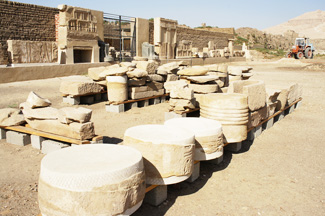 We resumed our documentation, conservation, and restoration work at Medinet Habu last week, just before the Eid Al Adha began, the great Islamic festival of sacrifice. Luxor is actually quite busy with tourists, which is good to see; we’ve noticed an increase in numbers just since we arrived. During the Eid we enjoyed a few days of quiet office work, and were back on site this past Tuesday. At the moment we are focusing mainly on Medinet Habu for the first part of the season in order to finish the drawings and photography for Medinet Habu Volume 10, followed closely by Medinet Habu Volume 11. Progress! The Luxor Temple work resumed this week, and will focus primarily on the blockyard, particularly the Thecla Church and Ptolemy I blocks. Our plan is to be back at TT 107 Nefersekheru’s tomb, in December, and at Khonsu Temple in February.
We resumed our documentation, conservation, and restoration work at Medinet Habu last week, just before the Eid Al Adha began, the great Islamic festival of sacrifice. Luxor is actually quite busy with tourists, which is good to see; we’ve noticed an increase in numbers just since we arrived. During the Eid we enjoyed a few days of quiet office work, and were back on site this past Tuesday. At the moment we are focusing mainly on Medinet Habu for the first part of the season in order to finish the drawings and photography for Medinet Habu Volume 10, followed closely by Medinet Habu Volume 11. Progress! The Luxor Temple work resumed this week, and will focus primarily on the blockyard, particularly the Thecla Church and Ptolemy I blocks. Our plan is to be back at TT 107 Nefersekheru’s tomb, in December, and at Khonsu Temple in February.
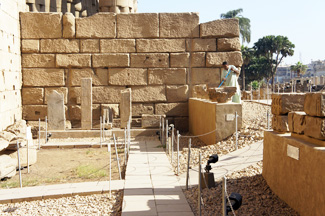 Life is full here, as usual. Accountant Essam and his wife Nidaa are still on the Hajj; we spoke by phone a few days ago and they are very well. We have seen a lot of the Tell Edfu crew this season; directors Nadine Moeller and Greg Marouard stayed with us over the Eid weekend, and the whole team joined us for our annual Halloween party last night. The Chicago House epigraphic team joined them at Edfu last week to consult on blockyard documentation strategies. That day I had a very pleasant meeting with Luxor governor Dr. Ezzat Saad, former Egyptian Ambassador to Russia, who has been reappointed for another term and has become a good friend. Emily Teeter and her tour, including some University of Chicago friends, were in town this week, and have just today departed for Cairo. We hosted site visits for the group at Luxor Temple and Medinet Habu where we showed them our work, and a reception and library briefing at Chicago House on Wednesday evening. Our Halloween Party last night was a great success, with about 80 foreign and Egyptian guests, always a great way to start the season!
Life is full here, as usual. Accountant Essam and his wife Nidaa are still on the Hajj; we spoke by phone a few days ago and they are very well. We have seen a lot of the Tell Edfu crew this season; directors Nadine Moeller and Greg Marouard stayed with us over the Eid weekend, and the whole team joined us for our annual Halloween party last night. The Chicago House epigraphic team joined them at Edfu last week to consult on blockyard documentation strategies. That day I had a very pleasant meeting with Luxor governor Dr. Ezzat Saad, former Egyptian Ambassador to Russia, who has been reappointed for another term and has become a good friend. Emily Teeter and her tour, including some University of Chicago friends, were in town this week, and have just today departed for Cairo. We hosted site visits for the group at Luxor Temple and Medinet Habu where we showed them our work, and a reception and library briefing at Chicago House on Wednesday evening. Our Halloween Party last night was a great success, with about 80 foreign and Egyptian guests, always a great way to start the season!
It is still warm in Upper Egypt, but the temperatures are slowly falling, especially at night, and it's noticeably cooler now (still in the 80s and 90s F during the day, though!). The month of November will see the continuation of our Medinet Habu and Luxor Temple documentation and preservation work. I will report on our activities at the end of the month, but in the meantime I would like to take this opportunity to extend our very best wishes to our friends back home for a happy November, and a joyous Thanksgiving holiday!
Best from Luxor,
Ray Johnson, Director
October 1, 2012
It’s that time again, with the autumn equinox passed, summer officially over, and only a few weeks left before the Chicago House staff heads back to Luxor. I am pleased to report that the Epigraphic Survey has received its work permissions for the 2012-2013 season from the Egyptian Ministry of Antiquities, and we are all set for our 89th archaeological field season and work at Medinet Habu, Luxor Temple, Khonsu Temple, and the tomb of Nefersekheru TT 107 from October 15th until April 15th. Tina is in the final weeks of cleaning and opening the facility, and reports that all is well in Luxor and Chicago House, despite the heat - it's still 104 F...!!!
Administrator Samir Guindy and the Chicago House workmen are all well, working hard with Tina to get the place ready, and looking forward to our return. Congratulations to senior accountant Essam and his wife Nidaa who will be going on the Hajj pilgrimage from October 13th until around November 10th. The kids will be staying with Nidaa’s family in Mansura while they are away. We will miss them all, but are very happy that they have this wonderful opportunity. Mabruk!
We will officially be in residence in Luxor from October 15th, and I will post monthly updates thereafter, so look for another posting in a few weeks. In the meantime, best wishes from all of us for a happy and prosperous autumn and winter!
Ray Johnson
2011-2012 Field Season
April 2, 2012
Dear Friends,
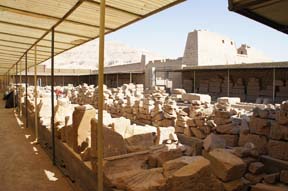 All is well here as we head into the last two weeks of our archaeological field season - where has the time gone? The temperatures are slowly rising, and with our Ministry of State for Antiquities (MSA) friends on both sides of the river we are tying up loose ends at Medinet Habu, Khonsu Temple, Luxor Temple, and Theban Tomb 107. We will close the Chicago House Library on April 10. March was full - of work, visitors, events, and more work. Conservator Lotfi Hassan, Nahed Samir Andraus, Mohamed Abu Makarem and their team continued to organize, treat, and mount sculpture and relief fragments in the small open-air museum of the Medinet Habu blockyard. Egyptologist Julia Schmied continued to sort and document material inside the blockyard, which photographer Yarko Kobylecky assisted by Ellie Smith extensively photographed in February and March. Stonemason Frank Helmholz finished his work with the Domitian Gate a few days ago, submitted his report, and is preparing for his and librarian Anait’s departure home in a few days. This past month Frank started cutting and shaping the new sandstone blocks that will replace some of the lower course blocks of the gateway, so decayed by groundwater salts they require complete replacement. Artist Keli Alberts continued her documentation of Ramesses III reliefs hidden by later Ptolemaic additions to the small Amun temple using aluminum foil rubbings and tracings, while senior artist Margaret De Jong continued to work with senior epigrapher Brett McClain on material for Medinet Habu volumes 10 and 11.
All is well here as we head into the last two weeks of our archaeological field season - where has the time gone? The temperatures are slowly rising, and with our Ministry of State for Antiquities (MSA) friends on both sides of the river we are tying up loose ends at Medinet Habu, Khonsu Temple, Luxor Temple, and Theban Tomb 107. We will close the Chicago House Library on April 10. March was full - of work, visitors, events, and more work. Conservator Lotfi Hassan, Nahed Samir Andraus, Mohamed Abu Makarem and their team continued to organize, treat, and mount sculpture and relief fragments in the small open-air museum of the Medinet Habu blockyard. Egyptologist Julia Schmied continued to sort and document material inside the blockyard, which photographer Yarko Kobylecky assisted by Ellie Smith extensively photographed in February and March. Stonemason Frank Helmholz finished his work with the Domitian Gate a few days ago, submitted his report, and is preparing for his and librarian Anait’s departure home in a few days. This past month Frank started cutting and shaping the new sandstone blocks that will replace some of the lower course blocks of the gateway, so decayed by groundwater salts they require complete replacement. Artist Keli Alberts continued her documentation of Ramesses III reliefs hidden by later Ptolemaic additions to the small Amun temple using aluminum foil rubbings and tracings, while senior artist Margaret De Jong continued to work with senior epigrapher Brett McClain on material for Medinet Habu volumes 10 and 11.
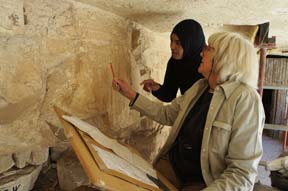 This week I finished director's reviews of the last of the reused-block drawings for this season at Khonsu Temple with epigrapher Jen Kimpton and artists Krisztian Vertes and Keli; our work there with the American Research Center in Egypt (ARCE) has now ended for this year. Margaret De Jong and I went over the last of her drawings for this season at TT 107, the tomb of Nefersekheru, with MSA Inspector Zeinab last week. Architect/artist Jay Heidel is working on the last of his AUTOCAD drawing collations of blocks from the two arches of the Thecla Church. In March he very successfully reassembled most of Arch #1 on one of our large mastaba platforms in the Luxor Temple blockyard with Sayid, Mohamed, Saoud, and MSA Inspector Marwa - a real milestone, and very sweet to see. We have most of the blocks from this arch, a great gift, but less of the blocks from Arch #2, that Jay is still analyzing. This summer he will prepare AUTOCAD elevations of the church sanctuary surviving lower walls, and will assemble scale drawings of the scattered architectural elements within it. This will give us the original height of the church sanctuary and will allow us to determine if - and how - we might physically restore parts of the sanctuary for public view in a future season. Throughout the winter I have been moving blocks that were reused in the foundations of the church (dismantled by the GOE in 1960) that were quarried from a monument of Ptolemy I at Karnak. After conservator Hiroko Kariya very kindly painted numbers on them, photographer Yarko and assistant Gharib photographed all of them this month (over 130 of them) so that we can analyze them over the summer.
This week I finished director's reviews of the last of the reused-block drawings for this season at Khonsu Temple with epigrapher Jen Kimpton and artists Krisztian Vertes and Keli; our work there with the American Research Center in Egypt (ARCE) has now ended for this year. Margaret De Jong and I went over the last of her drawings for this season at TT 107, the tomb of Nefersekheru, with MSA Inspector Zeinab last week. Architect/artist Jay Heidel is working on the last of his AUTOCAD drawing collations of blocks from the two arches of the Thecla Church. In March he very successfully reassembled most of Arch #1 on one of our large mastaba platforms in the Luxor Temple blockyard with Sayid, Mohamed, Saoud, and MSA Inspector Marwa - a real milestone, and very sweet to see. We have most of the blocks from this arch, a great gift, but less of the blocks from Arch #2, that Jay is still analyzing. This summer he will prepare AUTOCAD elevations of the church sanctuary surviving lower walls, and will assemble scale drawings of the scattered architectural elements within it. This will give us the original height of the church sanctuary and will allow us to determine if - and how - we might physically restore parts of the sanctuary for public view in a future season. Throughout the winter I have been moving blocks that were reused in the foundations of the church (dismantled by the GOE in 1960) that were quarried from a monument of Ptolemy I at Karnak. After conservator Hiroko Kariya very kindly painted numbers on them, photographer Yarko and assistant Gharib photographed all of them this month (over 130 of them) so that we can analyze them over the summer.
OI VC member Andrea Dudek was back with us in March helping librarian Marie Bryan continue the conversion of the Chicago House Library holdings to the Library of Congress system, now in its final stages. Andrea has given us a real boost; if all goes according to plan, we will be finished with the conversion next season. (Thank you, Andrea!). While she was with us, the Oriental Institute tour led by Lanny Bell and Amy Weber arrived in town. We gave them a very pleasant reception and library briefing at Chicago House on March 15th, and site visits a few days later (with Jen at Medinet Habu and Brett at Luxor Temple). Brett accompanied the group to Aswan and Cairo where he took Lanny’s place as ‘talking head’ when Lanny left for the US.
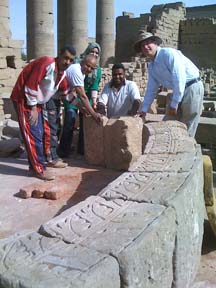 So it’s been the usual busy time for this part of the season. During the last two weeks Chicago House IT wizard Alain Arnaudies and Egyptologist wife Emmanuelle were back with us tweaking our master Chicago House Photo Archives database, entering more Medinet Habu and Luxor Temple documentation, refining the Helen and Jean Jacquet database, and assisting in working the bugs out of the Chicago House internal wireless network system. Tina Di Cerbo helped fill gaps in the data noted by Emmanuelle, and corrected incorrectly labeled photo numbers where necessary. Architect Louis Elia Louis finished the redrawing of the Nelson key plans in AUTOCAD of all the temple sites in Luxor, that can now be utilized at any scale. It is always a joy to have the Arnaudies with us, and their time passed all too quickly. At the moment, structural engineer Conor Power is with us for a few days for his annual structural condition study of Luxor Temple and the other monuments in our concessions.
So it’s been the usual busy time for this part of the season. During the last two weeks Chicago House IT wizard Alain Arnaudies and Egyptologist wife Emmanuelle were back with us tweaking our master Chicago House Photo Archives database, entering more Medinet Habu and Luxor Temple documentation, refining the Helen and Jean Jacquet database, and assisting in working the bugs out of the Chicago House internal wireless network system. Tina Di Cerbo helped fill gaps in the data noted by Emmanuelle, and corrected incorrectly labeled photo numbers where necessary. Architect Louis Elia Louis finished the redrawing of the Nelson key plans in AUTOCAD of all the temple sites in Luxor, that can now be utilized at any scale. It is always a joy to have the Arnaudies with us, and their time passed all too quickly. At the moment, structural engineer Conor Power is with us for a few days for his annual structural condition study of Luxor Temple and the other monuments in our concessions.
When next you hear from me, it will be from Chicago. We’re all departing Luxor by April 15th, all except Tina of course, who very kindly closes up the house and facility for us after we all leave, and who with our workmen puts Chicago House to sleep for the summer months. It has been a remarkable season in every way, productive and full. When I return to Luxor in July for our annual audit with senior accountant Essam El Sayed, administrator Samir Guindy, and assistant administrator Samwell Maher, Egypt will have a new president, and a lot of waiting will be over. We have all our fingers crossed for the future of this remarkable country.
Best wishes to you all from the Two Lands,
Ray Johnson
March 2, 2012
Dear Friends,
February has proven to be the busiest month of our Luxor archaeological field season so far, with streams of visitors (including my sister Carolyn on her first visit to Egypt), numerous tour groups (tourism is definitely on the rise), site and library briefings, colleagues passing through, lots of work milestones, and even a week-long African film festival. It’s been wild.
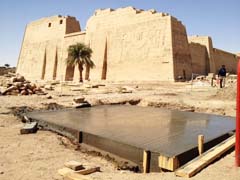 The work continues to go well. A few days ago Frank Helmholz and his team poured the new reinforced-concrete foundations of the dismantled Domitian gate, which will now ‘cure’ over the summer. In the meantime Frank and the guys will start carving sandstone blocks for the restoration of the gate that will begin next season. We loaned Frank to the American Research Center in Egypt (ARCE) for a few days’ emergency work in the Luxor Temple Ramesses II court week before last, where Frank successfully coordinated the repair of a broken abacus block high atop one the papyrus-bud columns on the eastern side of the court. Today (March 2) Frank, conservator Lotfi Hassan, conservator Hiroko Kariya and I hosted Gaetano Palumbo (World Monuments Fund [WMF] Program Director for North Africa, the Middle East, and Central Asia) on site briefings at Medinet Habu and Luxor Temple. At Luxor Temple Frank briefed Gaetano on the methodology we used for restoring 111 inscribed wall fragments back onto the original northeastern wall of the Amenhotep III court wall, finished in the spring of 2010. At Medinet Habu we discussed our ongoing conservation and restoration programs (the Ramesses III southern well; the Domitian Gate; the blockyard and open-air museum; small Amun temple conservation) the continuation of which has been greatly facilitated by the USAID-funded dewatering program activated a little more than a year ago.
The work continues to go well. A few days ago Frank Helmholz and his team poured the new reinforced-concrete foundations of the dismantled Domitian gate, which will now ‘cure’ over the summer. In the meantime Frank and the guys will start carving sandstone blocks for the restoration of the gate that will begin next season. We loaned Frank to the American Research Center in Egypt (ARCE) for a few days’ emergency work in the Luxor Temple Ramesses II court week before last, where Frank successfully coordinated the repair of a broken abacus block high atop one the papyrus-bud columns on the eastern side of the court. Today (March 2) Frank, conservator Lotfi Hassan, conservator Hiroko Kariya and I hosted Gaetano Palumbo (World Monuments Fund [WMF] Program Director for North Africa, the Middle East, and Central Asia) on site briefings at Medinet Habu and Luxor Temple. At Luxor Temple Frank briefed Gaetano on the methodology we used for restoring 111 inscribed wall fragments back onto the original northeastern wall of the Amenhotep III court wall, finished in the spring of 2010. At Medinet Habu we discussed our ongoing conservation and restoration programs (the Ramesses III southern well; the Domitian Gate; the blockyard and open-air museum; small Amun temple conservation) the continuation of which has been greatly facilitated by the USAID-funded dewatering program activated a little more than a year ago.
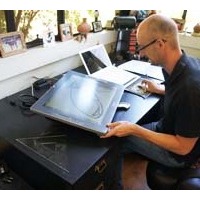 Last week we resumed our work at Khonsu Temple, Karnak, recording reused blocks in the flooring of chamber 2 and a lower wall of chamber 7 in coordination with the ARCE conservators and workmen in the final stages of floor and wall restoration there. Identifiable blocks whose recording we have started include an upper-wall cartouche frieze of Thutmosis IV and another of Ramesses II. The number of blocks left to record this season is small, and we expect our documentation work to be finished by the end of the month.
Last week we resumed our work at Khonsu Temple, Karnak, recording reused blocks in the flooring of chamber 2 and a lower wall of chamber 7 in coordination with the ARCE conservators and workmen in the final stages of floor and wall restoration there. Identifiable blocks whose recording we have started include an upper-wall cartouche frieze of Thutmosis IV and another of Ramesses II. The number of blocks left to record this season is small, and we expect our documentation work to be finished by the end of the month.
The Malkata team from the Metropolitan Museum of Art finished their work at the palace of Amenhotep III on Wednesday and departed Luxor this week; Peter Lacovara from Emory University is leaving in a few days. I accompanied the group on a review of the five-kilometer long palace complex concession on Wednesday and was overjoyed to see that the 11-kilometer protective wall around the site is intact, and working. There have been no illegal incursions into the site since the wall was finished by the Ministry of State for Antiquities just before the Egyptian revolution a year ago; it’s a miracle. Peter and I are among the invited speakers at the International Research Conference ‘In Search of New Concepts and Technologies for Conservation and Preservation of the Colossi of Memnon and the Mortuary Temple of Amenhotep III’ being held at the Luxor Museum and on site in western Thebes this weekend, from March 3rd – 5th. The conference will be celebrating Hourig Sourouzian’s re-erection of the first of two fallen quartzite colossi of Amenhotep III behind the famous Colossi of Memnon and her many other astonishing achievements in Amenhotep III’s shattered mortuary temple. I will present our Amenhotep III wall reconstruction work at Luxor Temple.
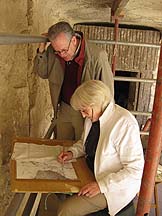 The recording of the reliefs in the tomb of Nefersekheru, the steward of Malkata palace (TT 107) by senior artists Sue Osgood and Margaret De Jong is in the final stretch. Sue finished her TT 107 and Medinet Habu small Amun temple (MH Volume 10) work in February and departed for home a few days ago. Margaret will be finished later this month. Milestones! Architect Jay Heidel returned from Sheikh Abada / Antinoupolis in Middle Egypt last week and resumed his documentation work with the Thecla Church blocks, as well as Luxor Temple signage design. Hiroko finished condition-monitoring and studying a group of buried blocks along the eastern exterior of the Colonnade Hall, too fragile to move at this time but protected from further decay by their burial.
The recording of the reliefs in the tomb of Nefersekheru, the steward of Malkata palace (TT 107) by senior artists Sue Osgood and Margaret De Jong is in the final stretch. Sue finished her TT 107 and Medinet Habu small Amun temple (MH Volume 10) work in February and departed for home a few days ago. Margaret will be finished later this month. Milestones! Architect Jay Heidel returned from Sheikh Abada / Antinoupolis in Middle Egypt last week and resumed his documentation work with the Thecla Church blocks, as well as Luxor Temple signage design. Hiroko finished condition-monitoring and studying a group of buried blocks along the eastern exterior of the Colonnade Hall, too fragile to move at this time but protected from further decay by their burial.
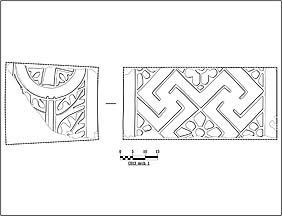 On February 21st I gave a workshop for Karnak inspectors on Chicago House's numerous epigraphic recording techniques at the ARCE conservation lab classroom next to Khonsu Temple. On February 23rd Malkata surveyor Joel Paulson very kindly showed a group of us what his Leica 3-D scanner (that he has been using to record Malkata palace mud-brick walls) could do with inscribed stone walls. The results reinforced our desire to add 3-D digital imaging to our Luxor documentation program in the future.
On February 21st I gave a workshop for Karnak inspectors on Chicago House's numerous epigraphic recording techniques at the ARCE conservation lab classroom next to Khonsu Temple. On February 23rd Malkata surveyor Joel Paulson very kindly showed a group of us what his Leica 3-D scanner (that he has been using to record Malkata palace mud-brick walls) could do with inscribed stone walls. The results reinforced our desire to add 3-D digital imaging to our Luxor documentation program in the future.
Since I still have to prepare for my conference talk on Sunday, I must close for now and get back to it. But as you can see from the above it has been a busy and very normal February for us. Tourism is on a slow rise, there are lots of visitors and colleagues in town (our library was packed with patrons today), and our work is going well. I should also mention that we are receiving excellent reports on the Oriental Institute Museum's latest exhibition about the history of the Oriental Institute's archaeological recording, 'Picturing the Past: Imaging and Imagining the Ancient Middle East' with a section on the work of the Epigraphic Survey. You can download the beautiful exhibition catalogue here:
http://oi.uchicago.edu/research/pubs/catalog/oimp/oimp34.html
Best wishes to you all, from all of us here at Chicago House,
Ray Johnson
February 2, 2012
Dear Friends,
All is well with us in Luxor, although it is hard to believe that January is already past. It has been unusually cold - Alexandria actually got some snow two weeks ago, a decidedly rare event! But we have been lucky here; the sun has been warm, and cloudy days few. The forecast is for temperatures to start a slow climb starting this holiday weekend, the Prophet’s Birthday / Mulid el-Nabi (on Saturday).
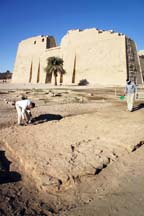 During the first month of 2012 Chicago House made progress on all work fronts. The last three courses of the Domitian Gate at Medinet Habu, threatened with collapse due to groundwater salt decay, were successfully dismantled by our skilled stone team. The rubble foundations of the gate, restored by George Daressy in the late 19th century, were photographed and cleared, including many inscribed fragments and architectural elements that have been transferred to the new blockyard for recording. Stone mason Frank is now preparing to lay a new, damp-coursed reinforced-concrete footing half a meter thick on which we will re-erect the gate next season after the footing has cured over the summer. He will also be cutting and preparing new sandstone blocks to replace some of the lower course blocks that were destroyed by salt. The epigraphic team supervised by senior epigrapher Brett McClain has been working hard in the small Amun temple ambulatory documenting reliefs that will be published in the next volume in that series. In addition to the normal drawing, artist Keli Alberts has been doing aluminum foil rubbings of inscribed wall surfaces now covered by later walls - a technique we perfected at Khonsu Temple - that she then traces, and which will be later scanned and reduced for inking.
During the first month of 2012 Chicago House made progress on all work fronts. The last three courses of the Domitian Gate at Medinet Habu, threatened with collapse due to groundwater salt decay, were successfully dismantled by our skilled stone team. The rubble foundations of the gate, restored by George Daressy in the late 19th century, were photographed and cleared, including many inscribed fragments and architectural elements that have been transferred to the new blockyard for recording. Stone mason Frank is now preparing to lay a new, damp-coursed reinforced-concrete footing half a meter thick on which we will re-erect the gate next season after the footing has cured over the summer. He will also be cutting and preparing new sandstone blocks to replace some of the lower course blocks that were destroyed by salt. The epigraphic team supervised by senior epigrapher Brett McClain has been working hard in the small Amun temple ambulatory documenting reliefs that will be published in the next volume in that series. In addition to the normal drawing, artist Keli Alberts has been doing aluminum foil rubbings of inscribed wall surfaces now covered by later walls - a technique we perfected at Khonsu Temple - that she then traces, and which will be later scanned and reduced for inking.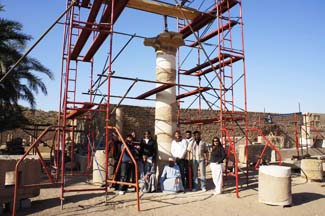 Artist/Egyptologist Krisztian Vertes has been dong a groundbreaking study of the different paint phases in the long history of the monument. He is painstakingly documenting the original painted phase of Thutmosis, III, a post- Amarna restoration phase, a 21st Dynasty renewal phase, and a final Ptolemaic phase. In each of these phases the color scheme of the scenes changes, sometimes quite dramatically. At the Medinet Habu blockyard conservator Lotfi Hassan has tested the joins of five sections of a five and a half meter tall, inscribed palm column from the original Ramesses III palace on the southern side of the mortuary temple. This column and its mates were taken down and replaced with bigger ones when Ramesses III increased the height of the hall later in his reign. The original column sections were reused elsewhere in the precinct where they were excavated and recovered by the Oriental Institute back in the 1920s. Lotfi has temporarily re-erected the entire column (minus its base) outside the blockyard, quite a sight, and we will discuss with the Ministry of Antiquities the possibility of erecting it and a second, partial column within the palace area for public view sometime in the future. Staff photographer Yarko Kobylecky and Ellie Smith have been steadily doing large-format and digital photography of dozens of blocks in the blockyard, many from 3rd Intermediate Period houses in the Medinet Habu complex, that Egyptologist Julia Schmied is identifying and analyzing as part of her PhD research and the first monograph in our Medinet Habu blockyard series.
Artist/Egyptologist Krisztian Vertes has been dong a groundbreaking study of the different paint phases in the long history of the monument. He is painstakingly documenting the original painted phase of Thutmosis, III, a post- Amarna restoration phase, a 21st Dynasty renewal phase, and a final Ptolemaic phase. In each of these phases the color scheme of the scenes changes, sometimes quite dramatically. At the Medinet Habu blockyard conservator Lotfi Hassan has tested the joins of five sections of a five and a half meter tall, inscribed palm column from the original Ramesses III palace on the southern side of the mortuary temple. This column and its mates were taken down and replaced with bigger ones when Ramesses III increased the height of the hall later in his reign. The original column sections were reused elsewhere in the precinct where they were excavated and recovered by the Oriental Institute back in the 1920s. Lotfi has temporarily re-erected the entire column (minus its base) outside the blockyard, quite a sight, and we will discuss with the Ministry of Antiquities the possibility of erecting it and a second, partial column within the palace area for public view sometime in the future. Staff photographer Yarko Kobylecky and Ellie Smith have been steadily doing large-format and digital photography of dozens of blocks in the blockyard, many from 3rd Intermediate Period houses in the Medinet Habu complex, that Egyptologist Julia Schmied is identifying and analyzing as part of her PhD research and the first monograph in our Medinet Habu blockyard series.
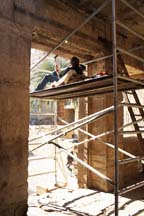 There are many comings and goings this month. Conservator Hiroko Kariya is splitting her time between the Luxor Temple blockyard; the Abydos mission of the NYU Institute of Fine Arts; and the UNESCO/Waseda University Amenhotep III tomb project where she is reassembling the granite lid of Amenhotep III's royal sarcophagus. Architect Jay Heidel is in Middle Egypt at Shiekh Abada / Antinoupolis assisting the Istituto Papirologico of the University of Florence, Italy with their survey of the Hadrianic Roman city; next week he will be helping them plan a multi-year geophysical survey of the site, increasingly threatened by encroaching agriculture and cemeteries. We are very pleased to welcome back the Malkata Palace expedition: Diana Craig Patch and Catharine Roehrig of the Metropolitan Museum of Art, and Peter Lacovara of Emory University, who with surveyor Joel Paulson and his wife Pam will be staying with us during the next month as they resume their archaeological work at Amenhotep III's sprawling palace site. You will recall that we are presently recording the reliefs and inscriptions on the façade of the tomb of Amenhotep III's Steward of Malkata palace, Nefersekheru (TT 107), in tandem with the renewed archaeological activity at the palace itself. Senior artists Margaret De Jong and Sue Osgood made great progress on the penciled drawings of the fragile limestone reliefs during the past month, and both will be finished with those drawings this season, with inking beginning this summer.
There are many comings and goings this month. Conservator Hiroko Kariya is splitting her time between the Luxor Temple blockyard; the Abydos mission of the NYU Institute of Fine Arts; and the UNESCO/Waseda University Amenhotep III tomb project where she is reassembling the granite lid of Amenhotep III's royal sarcophagus. Architect Jay Heidel is in Middle Egypt at Shiekh Abada / Antinoupolis assisting the Istituto Papirologico of the University of Florence, Italy with their survey of the Hadrianic Roman city; next week he will be helping them plan a multi-year geophysical survey of the site, increasingly threatened by encroaching agriculture and cemeteries. We are very pleased to welcome back the Malkata Palace expedition: Diana Craig Patch and Catharine Roehrig of the Metropolitan Museum of Art, and Peter Lacovara of Emory University, who with surveyor Joel Paulson and his wife Pam will be staying with us during the next month as they resume their archaeological work at Amenhotep III's sprawling palace site. You will recall that we are presently recording the reliefs and inscriptions on the façade of the tomb of Amenhotep III's Steward of Malkata palace, Nefersekheru (TT 107), in tandem with the renewed archaeological activity at the palace itself. Senior artists Margaret De Jong and Sue Osgood made great progress on the penciled drawings of the fragile limestone reliefs during the past month, and both will be finished with those drawings this season, with inking beginning this summer.
So it's business as usual here in Luxor as Egypt continues down the sometimes- rocky path to democracy. We continue to assist our Egyptian friends in any way we can, with our library, our site work, and all the resources at our disposal. We are very pleased and proud to be representing the Oriental Institute, the University of Chicago, and the USA here at this historic time.
Best wishes to you all from Luxor,
Ray Johnson
December 29, 2011
Dear Friends,
Holiday greetings to you all! Things are quiet and peaceful here in Luxor after a lovely Christmas. A number of the Chicago House staff returned home for the holidays as well as many of our colleagues, but the rest of us have enjoyed a warm and pleasant holiday time in Luxor. Our Christmas dinner was quite festive with many friends (Egyptian, Japanese, Italian, Canadian, and even some Americans) and LOTS of kids. The residence courtyard after dinner was like a hippodrome, with eight very small children racing round and around led by a very energetic two-year old! It was very sweet.
But our holiday joy has been considerably muted by the loss of a very dear colleague. Conservator Luigi de Cesaris, who coordinated the ARCE/Chicago House Roman fresco cleaning project at Luxor Temple, was felled suddenly by a heart attack on December 19th as he was finishing up work at the Red Monastery with his team. Luigi was well known for the high quality of his conservation work, his extraordinary energy, and his richness of spirit, and he was a dear friend to us all at Chicago House. His funeral - that Jay and I attended as representatives of Chicago House - took place on Thursday the 22nd at the church of San Luigi de Francese in Rome. He was interred in a little village cemetery hanging off the mountainside two hours south of Rome, with a small bouquet of roses from the Chicago House garden that he loved so much. Luigi was a presence in Egypt since the 1980s when he worked with the Getty Conservation Institute team cleaning and consolidating Nefertary’s famous tomb in the Valley of the Queens, followed by work sponsored by USAID and ARCE at the monasteries of St. Anthony and St. Paul on the Red Sea coast, and most recently at the Red Monastery in Sohag. He was only 50, leaves a young widow and three-year-old son, and big hole in all our hearts.
Our archaeological fieldwork continues to go very well. As I write this we are expanding the protective roofing along the inside walls of the Medinet Habu blockyard under Lotfi’s careful supervision, and hope to have that finished during the first week of January. The Domitian gate is now down to its last course, and we reviewed stonemason Frank’s plans for the new, reinforced foundation with our Egyptian Supreme Council of Antiquities friends two weeks ago. The foundation will be of reinforced concrete, and the decayed stone block courses will be replaced by new sandstone blocks quarried from the same quarries as the original blocks, shaped by Frank and his team in the months ahead. Sue Osgood is on her last drawing enlargement of the beautifully carved, Amenhotep III period reliefs in TT 107, the Theban tomb of Malkata palace steward Nefersekheru. Artist Margaret will be returning at the beginning of January to finish her drawings there as well. Documentation and collation of the Thecla church blocks continues in the Luxor Temple blockyard by Jay, while Hiroko, our workmen, and I have moved over 120 Ptolemaic and miscellaneous blocks and block fragments to separate mastaba platforms for photography and analysis. It’s been a good few months.
And we look forward to the new year. Best wishes to you all for a happy and prosperous New Year 2012 from all of us in Luxor…!
Ray Johnson
December 2, 2011
Dear Friends,
I am pleased to report that Luxor has been peaceful throughout the last few weeks, and the Chicago House team is busy and well. Our work at Medinet Habu, TT 107, and Luxor Temple has proceeded normally, and continued through the disturbances in Cairo with no interruption. The elections so far - here, in Cairo, Alexandria, and elsewhere - have been noteworthy for their orderliness, peaceful nature, enthusiasm, and unprecedented turnout. It's an encouraging beginning! And history in the making.
Yesterday artist Sue Osgood returned to Luxor to continue working in TT 107, the tomb of Nefersekheru, steward of Amenhotep III's Malkata palace, where Margaret has been drawing for the last month. Tomorrow conservator Hiroko Kariya arrives to resume conservation work in the Luxor Temple blockyards. On Sunday we are all heading south to see the current excavation work of faculty member Nadine Moeller, husband Gregory, and her team (including Hratch Papazian) at Tell Edfu. Nadine and the crew joined us and a number of our American (ARCE Luxor), foreign, and Egyptian colleagues for a very pleasant Thanksgiving dinner on November 24th. The cranberry sauce was home-made by artist Margaret De Jong, with fresh berries kindly hand-carried by library assistant (and OI VC member) Andrea Dudek who will be heading homeward in a few days after a very productive few weeks with us.
Thus far, outside of the election excitement, it's been a totally normal season. Two weeks ago I participated in a workshop in Cairo sponsored by AUC and the Netherlands/Flemish Institute on archaeological recording techniques, with a special emphasis on new digital recording technologies that we are using in our on site documentation work now. During the next couple of days a group of students from the Netherlands/Flemish Institute will be visiting TT 107 and Medinet Habu to see our recording methodologies in person, guided by Senior epigrapher Brett McClain and Margaret.
Despite the political uncertainties and bumps in the road, the last month and a half have been joyous in many ways. The Egyptian people are tremendously excited and proud of their new freedom to choose their leaders, and this has been a joy to witness. We gave our Egyptian staff the day off on Monday to vote, and each one proudly showed me his ink-stained finger (proof of voting) the day after. There have been other reasons to celebrate as well; I have attended two engagement parties for offspring of our workers (who were babies the last time I looked, and are now getting married?). And ten days ago Medinet Habu conservator Nahed gave birth to a baby boy, Jovan. Life is too full!
And all is well. I will write again soon. Best wishes to you all for an excellent December!
Best from Luxor,
Ray Johnson
October 31, 2011
Dear friends,
Chicago House opened for the 2011- 2012 archaeological field season on October 15th, we reopened the library this week, and I am pleased to report that all is well here in Luxor. I had a good few days in Cairo beforehand signing the season contract with the Egyptian Supreme Council of Antiquities, meeting the new US ambassador to Egypt Anne Patterson, as well as the new folk at USAID Egypt. Luxor is peaceful and pleasantly busy. The Chicago House epigraphic and conservation teams are now back working at Medinet Habu and at Luxor Temple, and we resumed our documentation work at Theban Tomb 107 (from the time of Amenhotep III) today. The weather has been glorious - hot during the day, but deliciously cool at night, and the temps are slowly going down. The number of tourists has been steadily and noticeably growing since we returned. The temples are busy again, which is very good to see, and makes everyone happy. Construction of the new Corniche in front of Chicago House has accelerated, trees are being planted, and new pedestrian walkways are being put in now along the lower terrace (allaying our fears that it might go back to being a highway). It is good to be back, and we are looking forward to a full and productive season with our Egyptian and foreign colleagues in Luxor.
I'll be in touch again soon.
Best to you all from Luxor,
Ray Johnson
October 1, 2011
Dear Friends,
The Epigraphic Survey is returning to Egypt to resume its documentation, conservation, and restoration work in Luxor. We plan to open Chicago House (being made ready for us now) on October 15, and the library the following week. I will post occasional updates on this web page throughout the winter.
Best wishes,
Ray Johnson
Director,
Epigraphic Survey
2010-2011 Field Season
EPIGRAPHIC SURVEY/CHICAGO HOUSE
Archaeological Field Activities in Luxor
October 15, 2010 - April 15, 2011
W. Raymond Johnson, Director
On April 15, 2011 the Epigraphic Survey, in collaboration with the Egyptian Supreme Council of Antiquities/Ministry of State for Antiquities Affairs, completed its eighty-seventh, six-month field season in Luxor. Because Luxor remained secure during the enormous changes that took place during Egypt's revolution this winter, Chicago House's activities ran uninterrupted from October 15, 2010 through April 15, 2011. Projects included epigraphic documentation, conservation, and restoration work at Medinet Habu; the inauguration of a new documentation program at the Theban Tomb 107 of Nefersekheru; salvage documentation at Khonsu Temple at Karnak (in cooperation with the American Research Center in Egypt / ARCE); and conservation, restoration, and maintenance of the blockyard open-air museum at Luxor Temple, as well as documentation of blocks from the Basilica of St. Thecla in front of the Ramesses II eastern pylon.
MEDINET HABU
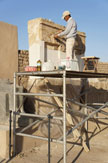 Epigraphic documentation supervised by senior epigrapher Brett McClain, senior artists Susan Osgood and Margaret De Jong, and artists Krisztian Vertes and Keli Alberts continued in the small Amun temple of Hatshepsut and Thutmosis III at Medinet Habu. Work continued primarily in the Thutmoside bark sanctuary ambulatory and its façade. Epigrapher Virginia Emery assisted in the collation process during the month of January. Sue's work this season was concentrated primarily in the ambulatory and on the façade of the Small Temple, in particular on the Thutmoside architrave inscriptions and adjoining architectural elements of the façade, and on the pillars of the ambulatory. Krisztian finished recording a Thutmoside pillar on the eastern façade, north end, partially hidden by the addition of the Ptolemaic 'court' walls. Tina Di Cerbo and Richard Jasnow continued to document graffiti throughout the MH complex, particularly on the roof areas of the Ramesses III mortuary temple.
Epigraphic documentation supervised by senior epigrapher Brett McClain, senior artists Susan Osgood and Margaret De Jong, and artists Krisztian Vertes and Keli Alberts continued in the small Amun temple of Hatshepsut and Thutmosis III at Medinet Habu. Work continued primarily in the Thutmoside bark sanctuary ambulatory and its façade. Epigrapher Virginia Emery assisted in the collation process during the month of January. Sue's work this season was concentrated primarily in the ambulatory and on the façade of the Small Temple, in particular on the Thutmoside architrave inscriptions and adjoining architectural elements of the façade, and on the pillars of the ambulatory. Krisztian finished recording a Thutmoside pillar on the eastern façade, north end, partially hidden by the addition of the Ptolemaic 'court' walls. Tina Di Cerbo and Richard Jasnow continued to document graffiti throughout the MH complex, particularly on the roof areas of the Ramesses III mortuary temple.
Medinet Habu blockyard
The conservation team supervised by senior conservator Lotfi Hassan continued and finished the moving of fragmentary material from the old Medinet Habu blockyard to the new, protected blockyard built by Chicago House against the southern Ramesses III enclosure wall. 3500 blocks and block fragments from all parts of the complex were moved during the last three seasons, and 2450 have been documented and entered on the MH fragment database by Egyptologist Julia Schmied assisted by Egyptologist Christian Greco. Also included in the move to the new storage facility was the area behind the Gods Wives Chapels, where fragments and blocks were stored on cement platforms. That area is now clean, and the platforms dismantled. Once the moving of blocks and fragments was finished, the old walled blockyard east of the king's palace was dismantled (in March) and the area leveled as part of the site management program of the Medinet Habu precinct, all supported by a grant from USAID Egypt. Next season will mark the completion of a small open-air museum component in front of the new blockyard that has been constructed by Lotfi and the team for appropriate joined fragment and display groups, including some beautiful, decorated doorways from Ramesses III's mortuary temple palace, and red-granite false door, broken in three pieces in the medieval period (and used as an olive press), from Amenhotep II's mortuary temple.
The Domitian Gate
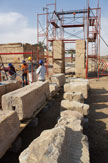 This season marks the beginning of a new chapter of our Medinet Habu restoration work. Last season we noted that the 1st century AD sandstone Gate of the Roman Emperor Domitian, reassembled by George Daressy from scattered blocks in the late 19th century (behind the small Amun temple) was in danger of collapse due to groundwater salt decay of its foundations. This past January the Egyptian-style, Roman monument was photographed by Chicago House photographer Yarko Kobylecky assisted by Ellie Smith. Afterward the gate was carefully surveyed and architectural drawings generated by stonemason Frank Helmholz. Because the USAID-funded, west-bank dewatering program was inaugurated earlier (in September of 2010), the ground was already showing signs of drying out by the new year. I should mention that by the time we finished work in mid-April, the water level in the Medinet Habu sacred lake was down three meters and back to levels recorded during the Oriental Institute's first work at Medinet Habu in the 1920s and 30s — a great success. In February dismantling of the gate commenced by Frank and the Chicago House workmen, and continued during March. 43 blocks (out of 68 total) are now stored on protected platforms immediately to the north of the gate, and will undergo any conservation and consolidation necessary next season. Three courses of stone blocks remain, and now that there is much less weight pushing down on the stones, there is no longer any threat of collapse. The dismantling will be finished next season, and during that time Frank and his team will also cut and shape new foundation blocks for the re-erection of the gate, scheduled to begin in 2012.
This season marks the beginning of a new chapter of our Medinet Habu restoration work. Last season we noted that the 1st century AD sandstone Gate of the Roman Emperor Domitian, reassembled by George Daressy from scattered blocks in the late 19th century (behind the small Amun temple) was in danger of collapse due to groundwater salt decay of its foundations. This past January the Egyptian-style, Roman monument was photographed by Chicago House photographer Yarko Kobylecky assisted by Ellie Smith. Afterward the gate was carefully surveyed and architectural drawings generated by stonemason Frank Helmholz. Because the USAID-funded, west-bank dewatering program was inaugurated earlier (in September of 2010), the ground was already showing signs of drying out by the new year. I should mention that by the time we finished work in mid-April, the water level in the Medinet Habu sacred lake was down three meters and back to levels recorded during the Oriental Institute's first work at Medinet Habu in the 1920s and 30s — a great success. In February dismantling of the gate commenced by Frank and the Chicago House workmen, and continued during March. 43 blocks (out of 68 total) are now stored on protected platforms immediately to the north of the gate, and will undergo any conservation and consolidation necessary next season. Three courses of stone blocks remain, and now that there is much less weight pushing down on the stones, there is no longer any threat of collapse. The dismantling will be finished next season, and during that time Frank and his team will also cut and shape new foundation blocks for the re-erection of the gate, scheduled to begin in 2012.
THE TOMB OF NEFERSEKHERU TT 107
Last winter the Epigraphic Survey initiated a condition study and preliminary, photographic documentation at the tomb of Nefersekheru (TT 107), west of el-Khokha. Nefersekheru was Steward of Amenhotep III's sprawling jubilee palace complex south of Medinet Habu at Malkata, and his tomb is one of the largest late-Amenhotep III period private tombs in Thebes. Instead of facing east, as do all of the others (like Kheruef, Ramose, Amenemhet Surer, etc), it faces south, toward Malkata and the setting sun. No complete plan has ever been made for the tomb, and it has never been cleared. The only decoration known so far is along the outside of the broad hall, in sunk relief that is every bit as beautiful as the raised relief of the contemporary tomb of Kheruef nearby, that the Epigraphic Survey documented in the 1960s. In February of 2010 staff photography Yarko assisted by Ellie photographed the portico reliefs in preparation for drawing. Because of the fragile condition of the stone, non-invasive drawing on photographic enlargements was chosen as the medium of documentation. Before drawing began this season, and at the recommendation of structural engineer Conor Power, Chicago House erected a series of reinforcing screw jacks and wooden beams along the inside of the potentially unstable portico. The equipment was kindly lent to us by Kent Weeks, who had faced similar conditions during his work in KV 5 in the Valley of the Kings.
Once the portico was stabilized, artists Sue and Margaret began drawing the exquisite reliefs and inscriptions, starting in January. Cleaning and more permanent stabilization measures for the portico will follow, including restoration of the missing limestone columns.
KHONSU TEMPLE, KARNAK
This year marked the third season of an Epigraphic Survey and ARCE collaboration at Khonsu Temple, Karnak, part of the USAID-funded ARCE Groundwater Lowering Response Initiative. Part of ARCE's program focuses on conservation and restoration work in Khonsu Temple, including restoration of floor blocks where they are missing.
Chicago House senior epigrapher Brett McClain supervised the epigraphic team (Egyptologist Jen Kimpton, Egyptologist/artist Krisztian Vertes, artist Keli Alberts, and Ray Johnson) in the recording of the inscribed stone-blocks reused in the flooring, foundations, and western roof area of Ramesses III's Khonsu Temple. This documentation is necessary before ARCE's floor restoration work, involving repaving whole areas, makes the reused material inaccessible. All Chicago House recording work was done in coordination with ARCE Luxor director John Shearman and Karnak director Ibrahim Suleiman, and is an essential documentation component of the ARCE / SCA restoration program. All cleaning was done by the skilled MSA/SCA/ARCE workmen; Chicago House's work was strictly documentation.
The primary focus of the work this season was in the Khonsu front court, where the floor blocks are made up of material primarily from the time of Sety I, including a gigantic lintel several meters long inscribed with names and figures of this king worshipping the divine triad of Thebes. The material Chicago House has documented in the flooring of the rear sanctuary areas of Khonsu Temple suggests that Ramesses III dismantled a smaller, 18th Dynasty, square-pillared sanctuary of Khonsu from the time of Thutmosis III and utilized the stone from that structure in the foundations and flooring of his much larger structure. Blocks inscribed with the names of Thutmose III, Thutmose IV, Ay, Horemheb, Sety I, Ramesses II, and Sety II have all been documented in the flooring so far. Many of the Thutmoside raised-relief offering scenes show signs of reworking in sunk relief and appropriation by Ramesses II.
To date, the reused blocks and fragments recorded at Khonsu Temple during the 2008-2009, 2009-2010, and 2010-2011 seasons now total 652. In situ blocks from the flooring and foundations of Khonsu Temple total 309, while loose blocks and fragments total 343. The documentation and preliminary analysis of the blocks and fragments will appear in a series of preliminary reports in the Journal of the American Research Center.
LUXOR TEMPLE
This season, kindly supported by a grant from Nassef Sawiris, the Epigraphic Survey started cataloguing, documenting, and surveying the remains of the 6th century AD Basilica of St. Thecla located immediately north of the Roman wall, among the earliest known churchs in Luxor. This new project will allow us to integrate the church into the Luxor Temple Roman fortification-wall study, and is expected to provide vital information about the transition period between the pagan and Christian religions, a hitherto little known chapter in the history of Luxor Temple. 102 blocks from the original basilica sanctuary have already been located and moved to a special processing area east of the Colonnade Hall for cleaning by conservator Hiroko Kariya, and recording by architect Jay Heidel. Jay has drawn and entered 118 blocks (including some too big to move) into a specially designed database and is preparing AUTOCAD drawings for their reconstruction on paper. Already numerous joins among the blocks have been noted, including sections of a large, beautifully carved central arch, and the two granite columns and sandstone capitals that supported it. Future plans include a feasibility study for physically reconstructing some of the sanctuary blocks and architectural elements in situ as part of the comprehensive site management program for that area.
Educational signage for the main axis of the temple has been designed by Jay, beginning with an orientation panel for the entire temple complex that will appear outside the main entrance (now on the east side of the temple) in English and Arabic. Panels that have already been designed and are awaiting translation include a 'Ancient Thebes Orientation and Sphinx Avenue' in front of the temple, 'the Ramesses II pylon entryway,' 'the Ramesside Court,' 'the great Colonnade Hall,' 'the Amenhotep III court,' 'the Roman sanctuary,' and 'the Luxor Temple sanctuary.'
The Luxor Temple Blockyard Project.
The Luxor Temple blockyard conservation program was coordinated by Hiroko Kariya and assisted by Tina Di Cerbo and Nan Ray, and was supported by a Robert W. Wilson Challenge to Conserve our Heritage Grant and the World Monuments Fund (WMF).
The blockyard open-air museum was completed and opened to the public on March 29, 2010. It features a total of 169 pieces/groups (308 fragments - single and joined pieces) on 12 thematic mastaba platforms (a total of 142 meters in length). Displayed on these mastabas are 62 fragment groups arranged in chronological order (from the Middle Kingdom to the present) accompanied by educational signage. There are also mastabas on which fragments are organized thematically; a rotating display currently featuring ancient Egyptian creatures, large blocks from the Amenhotep III sanctuary of Luxor Temple, statues, stelae, door jambs, capitals, fragments showing ancient Egyptian masonry and conservation techniques, and finally, fragments uncovered during the Luxor Temple dewatering project. The display also includes the in-situ presentation of the great eastern Roman tetrastyle and fortified gateway into the precinct. The 200 meter-long paths adjacent to the display mastabas were paved and metal railings installed for the protection of the fragments. A total of 15 large and 43 small explanatory signs were installed. 34 spotlights were installed for illuminating the displays after dark, keyed to the temple lighting. Public viewing is now usually possible until 9:00 PM.
This season focused on followup work in the open-air museum as well as the usual conservation monitoring of the blockyard storage areas. This included cleaning and condition-surveying of the museum fragment-group displays and selected single fragments (all entered into the database by Nan), remounting a late-period stela, replacing and maintaining educational signage, and adding an additional fragment to the displayed relief of Thutmosis III. In order to reduce the amount of dirt/dust on the pavement, additional gravel was placed approximately one meter-wide along the western side of the paved path upon approval by the SCA. This has had a very positive effect of cutting down the dirt tracked onto the paving.
Luxor Temple Structural Condition Study
This season structural engineer Conor Power continued his condition study of the Luxor Temple structure in March, 2011. He found no discernable movement or destabilization of the Ramesses II pylons or great Colonnade Hall columns. Based on a comparison with photographs taken in the year 2000, Conor found that there is a noticeable reduction of overall moisture levels in the temple, and that moisture wicking has subsided. His conclusion is that the ground water lowering engineering project, activated in 2006, has had a positive effect on Luxor Temple with a reduction of salt efflorescence and moisture levels in the structure. Good news!
Luxor Update February 11, 2011
Dear Friends,
Well, it has happened. After a confusing speech last night, President Mubarak has just stepped down, the army has taken charge, and the Egyptian people have changed history. The celebrations are pretty extreme in Cairo and Alexandria, and I imagine elsewhere. It must be a heady feeling to suddenly find you have a voice when you never had one before. Luxor, in contrast, is fairly quiet. We are a bit away from things in town, but I have not heard the expected car horns, or music, or anything. We continue to remain in a strange bubble, seemingly outside of and largely unaffected by what has been happening in the north. While the people here have had their problems with the GOE, they largely blame the local government, and not Mubarak. The celebrations are muted here.
But the Chicago House team is all well, and now hopeful that things will get back to normal everywhere in the country. I have spoken to the local Supreme Council of Antiquities / Ministry of State for Antiquities Affairs director, and he is saying that nothing changes for the foreign missions, and we can keep our normal schedules. We will continue to play things by ear, keep the work going, and be here for our Egyptian friends, but we will also continue to be vigilant.
I will keep you posted during the next few days. Keep those prayers coming for Egypt.
Best from Luxor,
W. Raymond Johnson,
Director, Epigraphic Survey
Oriental Institute, University of Chicago
Chicago House, Luxor, Egypt
Luxor Update February 8, 2011
For those friends and colleagues who are concerned about the well-being of Chicago House and its staff during the events of this last two weeks in Egypt, I am happy to report that we are safe, Luxor is secure, and we have been keeping a normal work schedule on all of our project sites: Luxor Temple, Khonsu Temple Karnak, Medinet Habu, and the tomb of Nefersekheru TT 107. After some relatively minor (compared to Cairo and elsewhere) demonstrations and vandalism of government buildings during the afternoon and evening of Friday, January 28th, order was restored in Luxor the next day, and it has been peaceful here ever since. There was no damage to or looting of any archaeological site in Luxor. We have been in constant touch with the Egyptian Supreme Council of Antiquities / Ministry of State for Antiquities Affairs in Luxor, who informed us that archaeological missions could resume work on Sunday, January 30th. Police presence on the antiquities sites is strong, with some Egyptian military as well, and small groups of foreign and Egyptian tourists continue to visit the sites; a scattering of tourists is still being bused in from the Red Sea.
Two members of the Chicago House team have returned home (one who had no passport was assisted by the US Embassy which had a team in Luxor for a few days). While the rest of us are prepared to leave at a moment's notice, we will remain in Luxor for now and as long as we can to keep our documentation, conservation, and restoration work going with the SCA, and the library open for our Egyptian and foreign colleagues who have stayed to continue their work. Be assured that we will continue to monitor the situation in the country closely, but for now will continue to assist the scientific community in Luxor in any way we can.
Best from Luxor,
W. Raymond Johnson,
Director, Epigraphic Survey
Oriental Institute, University of Chicago
Chicago House, Luxor, Egypt
Luxor Update February 2, 2011
Dear friends,
Finally Egypt has Internet access again! Gil, Steve, and I have been in touch this last week by phone, and I know that Gil has sent out reports about our status. After the rioting on Friday and Saturday, I am happy to report that Luxor has been secure since the weekend, and Chicago House has been back at work on all sites since Sunday. While the situation is still of some concern in Cairo, all is well here, and those of us in town - the Egyptian SCA and a number of archaeological expeditions, including ARCE, the Germans at the Amenhotep III mortuary temple, the French at Karnak, etc - are all checking up on each other.
The US Embassy had some staff here for a few days facilitating the evacuation of people who needed to leave, but they are departing tonight, satisfied that everything is in good order here. There are even foreign tourists still around - there were ten tour buses in the Medinet Habu parking lot when we left at 1PM today! Weird.
We continue to monitor the situation, and are being cautious. At no time have we ever felt threatened. For now we will remain here and continue our work with our Egyptian and foreign colleagues, but we are prepared to leave if the situation requires it. I will keep you posted.
Best from Luxor,
W. Raymond Johnson,
Director, Epigraphic Survey
Oriental Institute, University of Chicago
Chicago House, Luxor, Egypt
We are very pleased to announce that all Medinet Habu volumes as well as the latest, OIP 136, Medinet Habu Volume IX, the Eighteenth Dynasty Temple Part 1, the Inner Sanctuaries (Chicago 2009), are now available for free PDF download from the Oriental Institute Publications Web site:
http://oi.uchicago.edu/research/pubs/catalog/egypt.html
Thanks to friends Lewis and Misty Gruber, who funded the digital scanning, and Tom Urban and Leslie Schramer of the OI Publications Office, all publications under the category "Egypt," including everything the Epigraphic Survey and Oriental Institute have ever published, are now available for download in the new digital format, completely free of charge.
2009-2010 Field Season
LUXOR TEMPLE
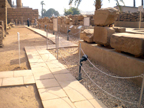
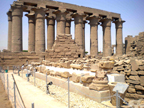 The Luxor Temple blockyard conservation program coordinated by Hiroko Kariya assisted by Tina Di Cerbo and Nan Ray continued with final preparations for the Luxor Temple blockyard open-air museum. This three-year project, supported by the World Monuments Fund (a Robert W. Wilson Challenge to Conserve Our Heritage grant) was completed and opened to the public on March 29, 2010 in a ribbon-cutting ceremony presided over by SCA Luxor director Mansour Boraik and about 100 friends and colleagues. More than sixty-two fragment groups have now been reassembled chronologically for public display with educational signage in English and Arabic. Sandstone pavement, protective fencing, and lighting for nighttime viewing are now in place to the east of the Luxor Temple sanctuary along platforms that support reassembled fragment groups from the Middle Kingdom through the Ptolemaic, Roman, Christian, and Islamic periods. Other platforms display material recovered during the USAID-supported dewatering trenching to the east of Luxor Temple by the Egyptian Supreme Council of Antiquities (SCA) and American Research Center in Egypt (ARCE), a conservation section, and a rotating exhibit section that now features "Egyptian Creatures" in art and inscriptions. An online catalogue of the museum displays is being prepared that will eventually be accessible from this Web site.
The Luxor Temple blockyard conservation program coordinated by Hiroko Kariya assisted by Tina Di Cerbo and Nan Ray continued with final preparations for the Luxor Temple blockyard open-air museum. This three-year project, supported by the World Monuments Fund (a Robert W. Wilson Challenge to Conserve Our Heritage grant) was completed and opened to the public on March 29, 2010 in a ribbon-cutting ceremony presided over by SCA Luxor director Mansour Boraik and about 100 friends and colleagues. More than sixty-two fragment groups have now been reassembled chronologically for public display with educational signage in English and Arabic. Sandstone pavement, protective fencing, and lighting for nighttime viewing are now in place to the east of the Luxor Temple sanctuary along platforms that support reassembled fragment groups from the Middle Kingdom through the Ptolemaic, Roman, Christian, and Islamic periods. Other platforms display material recovered during the USAID-supported dewatering trenching to the east of Luxor Temple by the Egyptian Supreme Council of Antiquities (SCA) and American Research Center in Egypt (ARCE), a conservation section, and a rotating exhibit section that now features "Egyptian Creatures" in art and inscriptions. An online catalogue of the museum displays is being prepared that will eventually be accessible from this Web site.
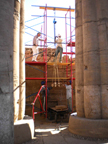
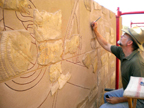 The culmination of the blockyard open-air museum is to be found inside the northeastern corner of Amenhotep III's solar court. Restoration of 111 wall fragments of Amenhotep III to the original east interior wall of the court was completed at the end of January by mason Frank Helmholz and the Chicago House workmen, assisted by Hiroko. The lime-plaster surface applied over the brick fill between the stone fragments was finished in early March by Hiroko and SCA conservators Salah Salim and Anwar Fouad Mahdi Jaama. The inner inscribed wall fragments and outer wall slabs were all built against an inner, specially constructed solid-brick core. Missing details were added in paint on the plaster by Ray Johnson in March and April. The 111 fragments complete a bark of the god Amun followed by a figure of Amenhotep III and the royal ka, complete to the top of the king's khepresh crown. The whole bark scene preserves many painted details, and was carved originally by Amenhotep III, destroyed by Akhenaten, restored by Tutankhamun, appropriated by Horemheb, and enlarged by Sety I, thereby reflecting the entire end of the 18th Dynasty and beginning of the 19th! The wall was quarried in the Middle Ages and broken up for reuse, excavated by the Egyptian government around 1958, stacked around the temple in the early 1960s, and was surveyed, documented, analyzed, and moved to a special holding area east of the temple by the Epigraphic Survey in the 1980s. It has now been restored to the original wall by the Survey, completing the cycle.
The culmination of the blockyard open-air museum is to be found inside the northeastern corner of Amenhotep III's solar court. Restoration of 111 wall fragments of Amenhotep III to the original east interior wall of the court was completed at the end of January by mason Frank Helmholz and the Chicago House workmen, assisted by Hiroko. The lime-plaster surface applied over the brick fill between the stone fragments was finished in early March by Hiroko and SCA conservators Salah Salim and Anwar Fouad Mahdi Jaama. The inner inscribed wall fragments and outer wall slabs were all built against an inner, specially constructed solid-brick core. Missing details were added in paint on the plaster by Ray Johnson in March and April. The 111 fragments complete a bark of the god Amun followed by a figure of Amenhotep III and the royal ka, complete to the top of the king's khepresh crown. The whole bark scene preserves many painted details, and was carved originally by Amenhotep III, destroyed by Akhenaten, restored by Tutankhamun, appropriated by Horemheb, and enlarged by Sety I, thereby reflecting the entire end of the 18th Dynasty and beginning of the 19th! The wall was quarried in the Middle Ages and broken up for reuse, excavated by the Egyptian government around 1958, stacked around the temple in the early 1960s, and was surveyed, documented, analyzed, and moved to a special holding area east of the temple by the Epigraphic Survey in the 1980s. It has now been restored to the original wall by the Survey, completing the cycle.
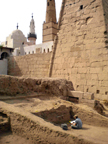 In collaboration with the SCA and American Research Center in Egypt (ARCE) at Luxor Temple, cleaning of the 3rd Century AD Roman fortification wall in front of the temple where it abuts the eastern pylon of Ramesses II was begun in preparation for consolidation and restoration next season, supervised by Pamela Rose. Educational signage for the temple proper was also begun, beginning with an orientation panel for the entire temple designed by Chicago House architect Jay Heidel.
In collaboration with the SCA and American Research Center in Egypt (ARCE) at Luxor Temple, cleaning of the 3rd Century AD Roman fortification wall in front of the temple where it abuts the eastern pylon of Ramesses II was begun in preparation for consolidation and restoration next season, supervised by Pamela Rose. Educational signage for the temple proper was also begun, beginning with an orientation panel for the entire temple designed by Chicago House architect Jay Heidel.
KHONSU TEMPLE
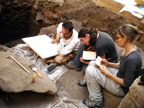 This year marked the second season of the Epigraphic Survey epigraphic team at Khonsu Temple, supervised by senior epigrapher Brett McClain in collaboration with the SCA and ARCE on the epigraphic recording of reused, inscribed stone-block material in the flooring and foundations of Ramesses III's Khonsu Temple. This documentation is necessary before floor restoration work makes the material inaccessible. 226 reused, inscribed blocks were recorded this season, and 161 drawings were cleared by the director. The documentation and analysis of the material, most of which appears to be part of an earlier, dismantled Khonsu Temple, will be completed during the 2010-2011 season.
This year marked the second season of the Epigraphic Survey epigraphic team at Khonsu Temple, supervised by senior epigrapher Brett McClain in collaboration with the SCA and ARCE on the epigraphic recording of reused, inscribed stone-block material in the flooring and foundations of Ramesses III's Khonsu Temple. This documentation is necessary before floor restoration work makes the material inaccessible. 226 reused, inscribed blocks were recorded this season, and 161 drawings were cleared by the director. The documentation and analysis of the material, most of which appears to be part of an earlier, dismantled Khonsu Temple, will be completed during the 2010-2011 season.
MEDINET HABU

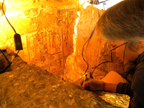 Epigraphic documentation supervised by senior artists Susan Osgood and Margaret De Jong continued in the small Amun temple of Hatshepsut and Thutmose III at Medinet Habu in the bark sanctuary ambulatory (Volumes X and XI) and bark sanctuary (Volume XII). Photography of the four Akoris columns was completed by photographer Yarko Kobylecky.
Epigraphic documentation supervised by senior artists Susan Osgood and Margaret De Jong continued in the small Amun temple of Hatshepsut and Thutmose III at Medinet Habu in the bark sanctuary ambulatory (Volumes X and XI) and bark sanctuary (Volume XII). Photography of the four Akoris columns was completed by photographer Yarko Kobylecky.
The conservation team supervised by Lotfi Hassan worked in the new Medinet Habu blockyard built against the inside southern Ramesses III enclosure wall. The inventorying, documentation, and moving of the miscellaneous fragmentary architectural and sculptural fragments from the old blockyard continued, coordinated by Julia Schmied and Christian Greco, and over 2,000 blocks have now been transferred to the new blockyard. The transfer will be finished next season, as well as an open-air museum component in front of the new blockyard that has been constructed for appropriate joined fragment and display groups.
THE TOMB OF NEFERSEKHERU TT 107
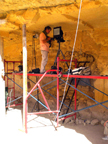 A condition study and preliminary photographic documentation of the tomb of Amenhotep III's Steward of Malkata Palace, the nobleman Nefersekheru, was begun in preparation for the stabilization and drawing of the portico area starting next season.
A condition study and preliminary photographic documentation of the tomb of Amenhotep III's Steward of Malkata Palace, the nobleman Nefersekheru, was begun in preparation for the stabilization and drawing of the portico area starting next season.


